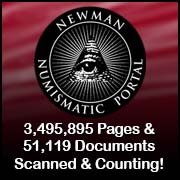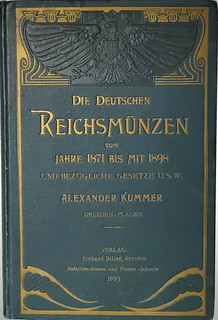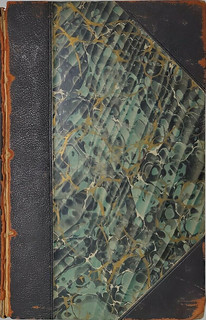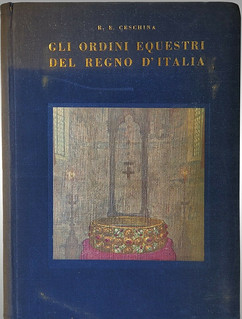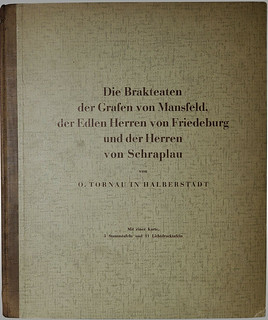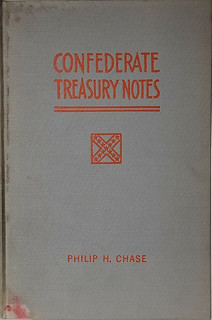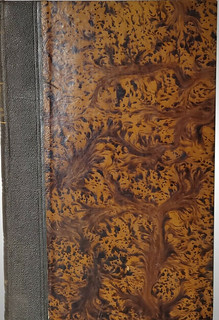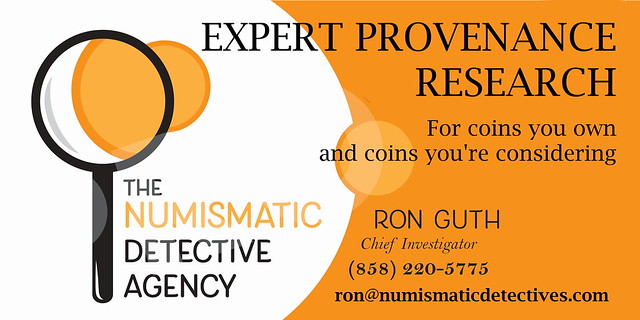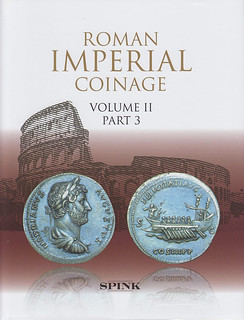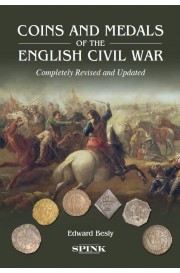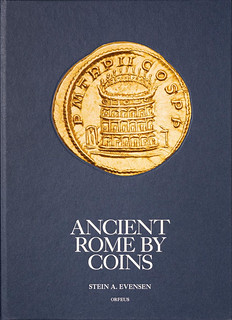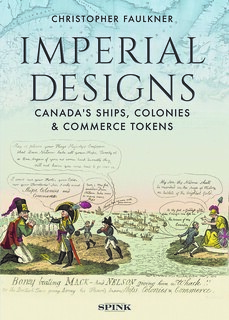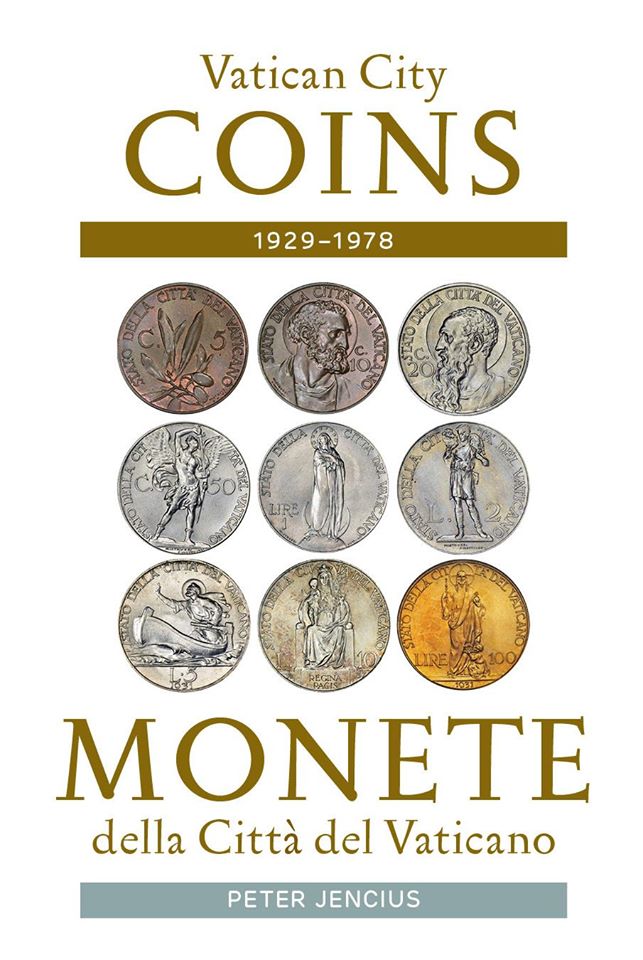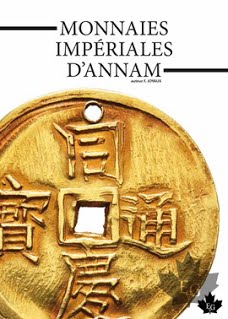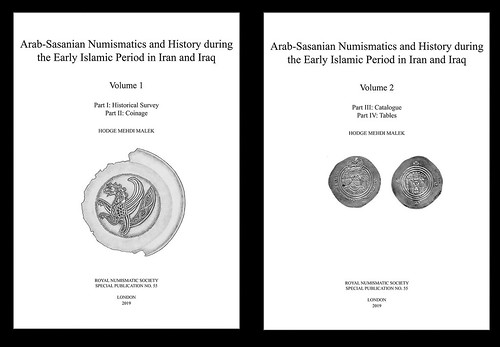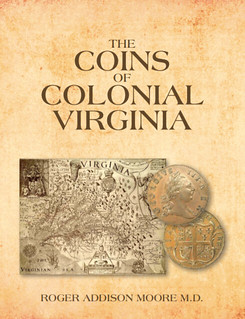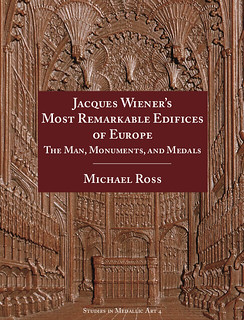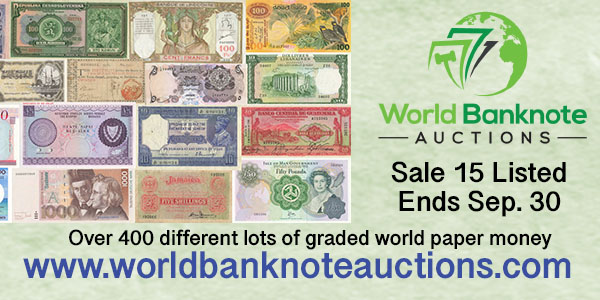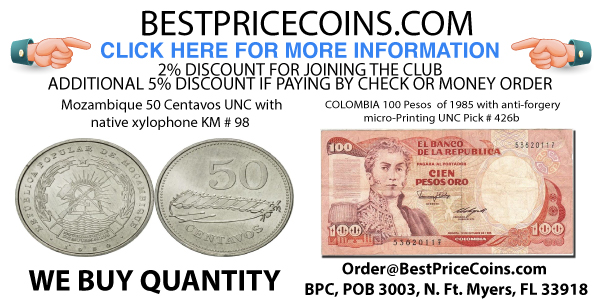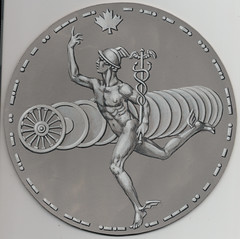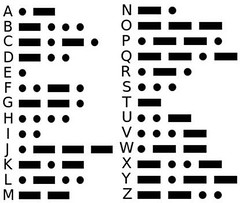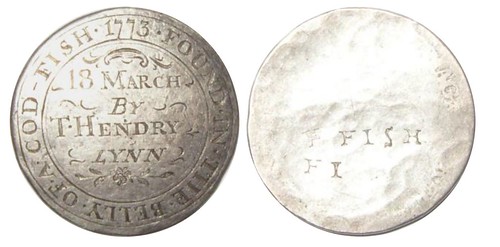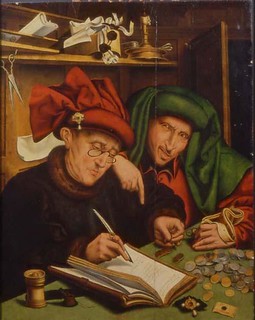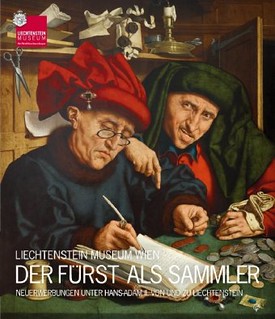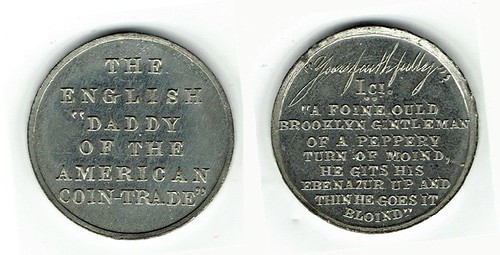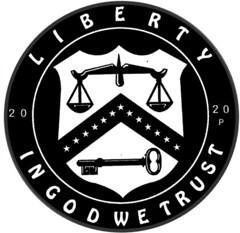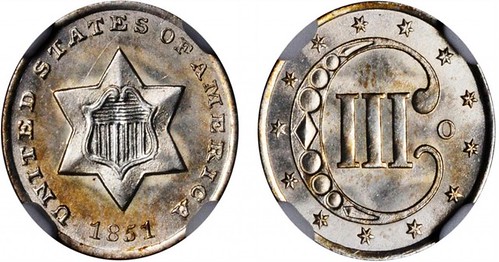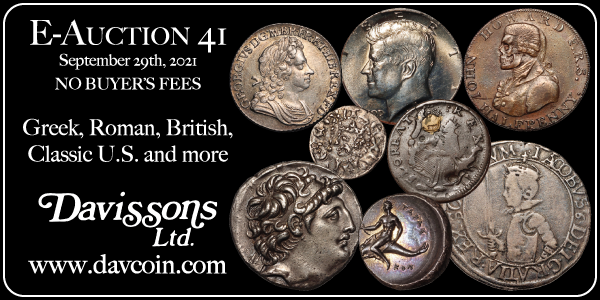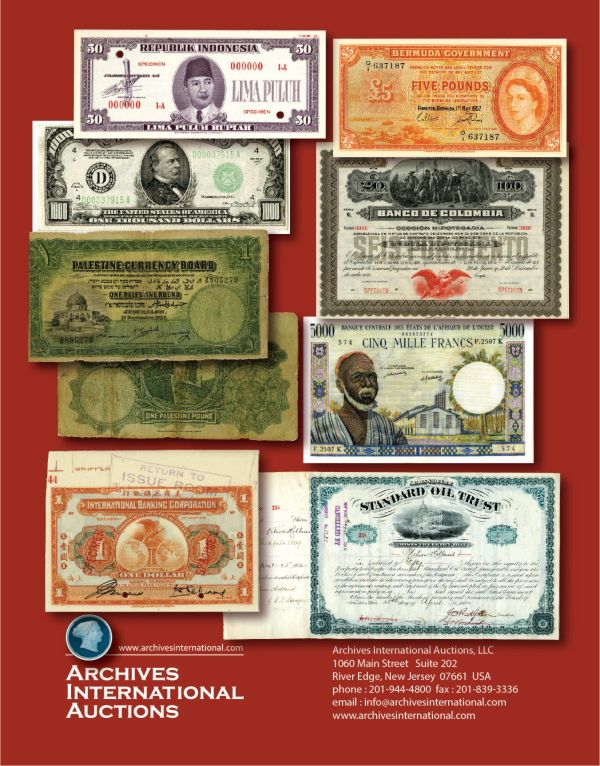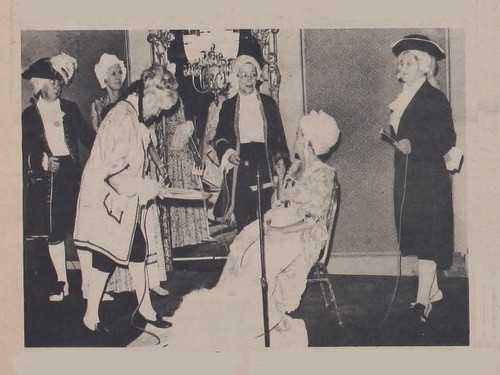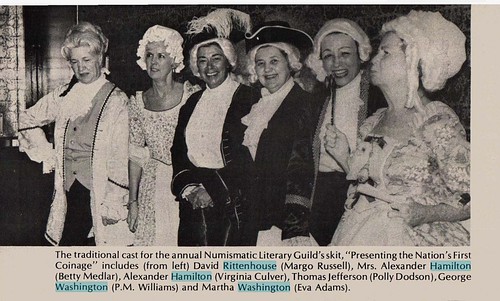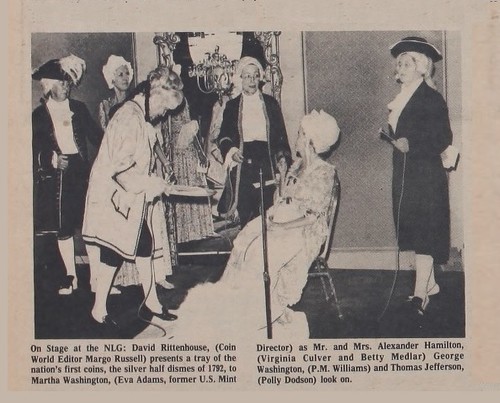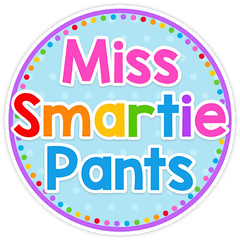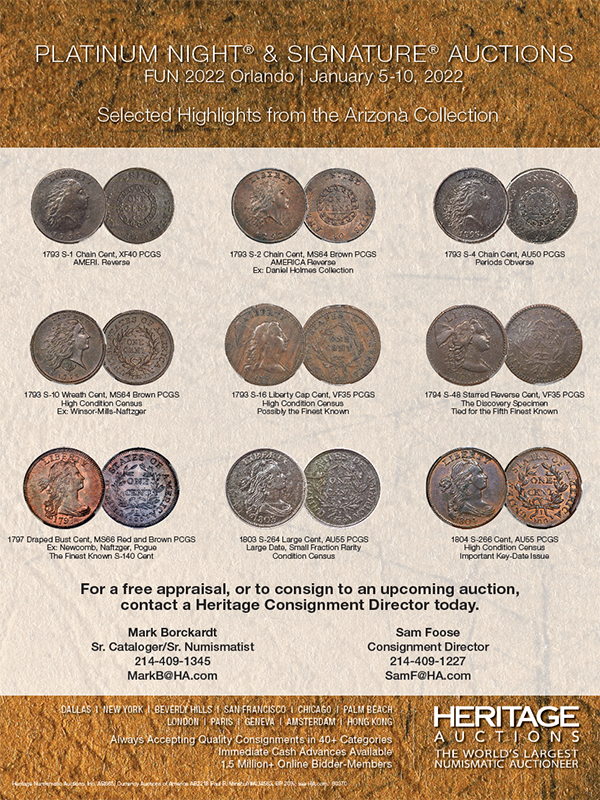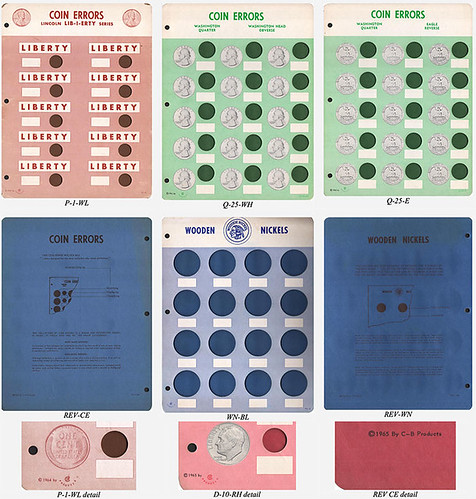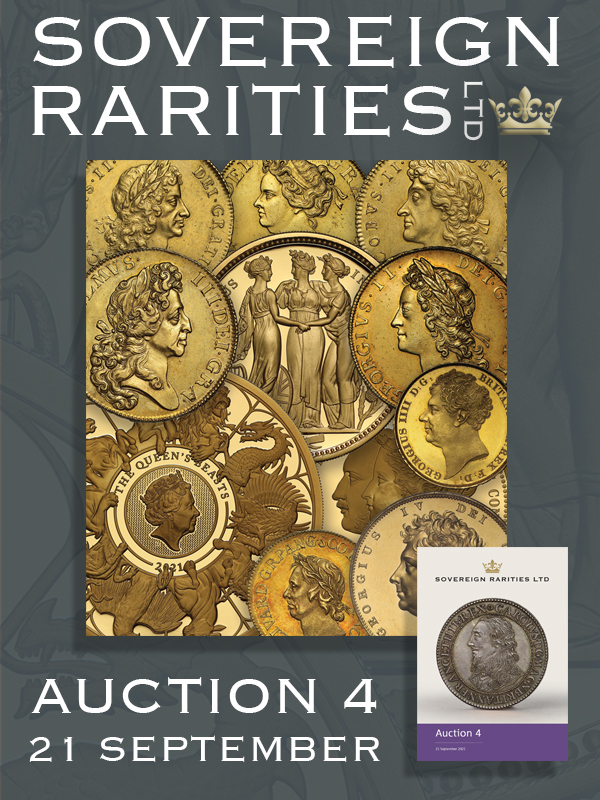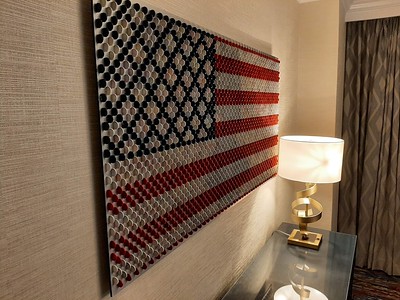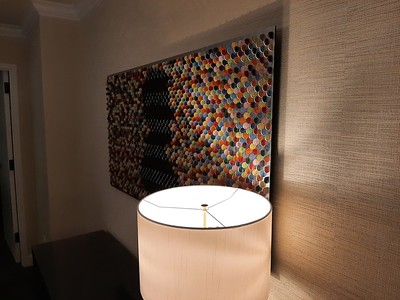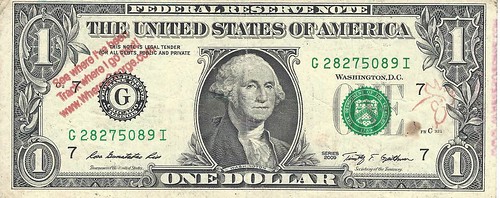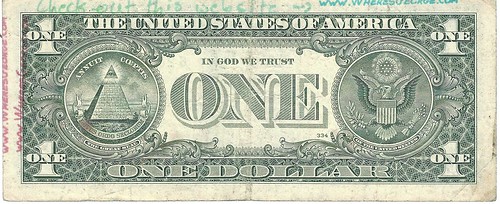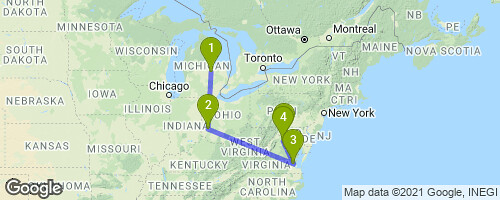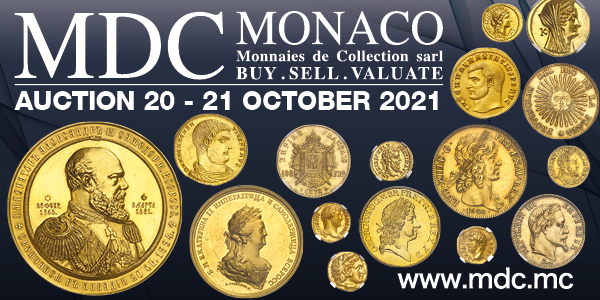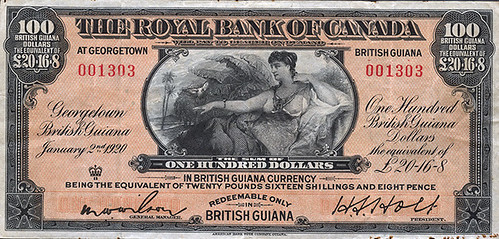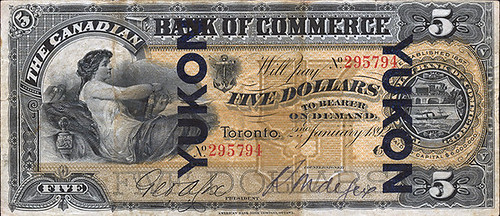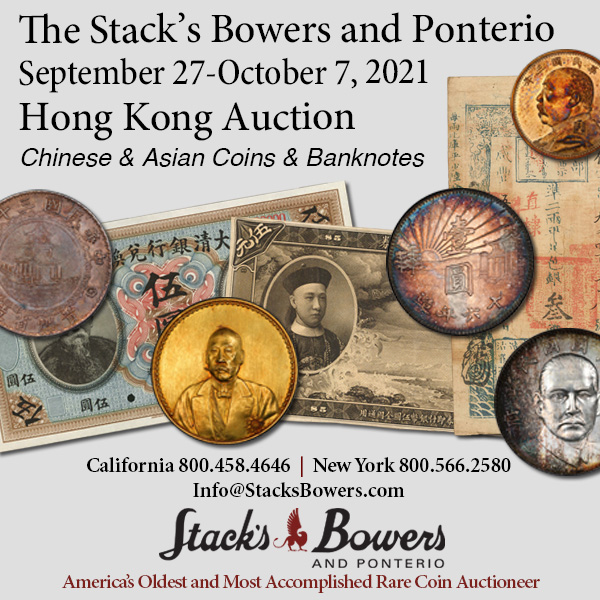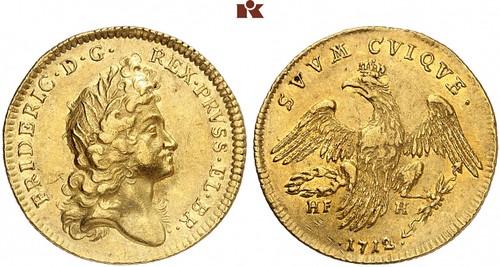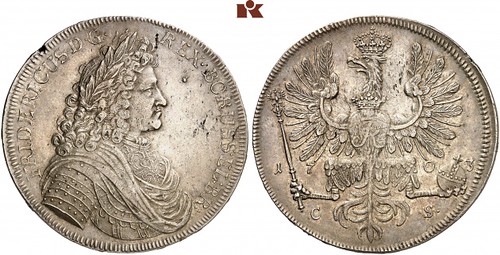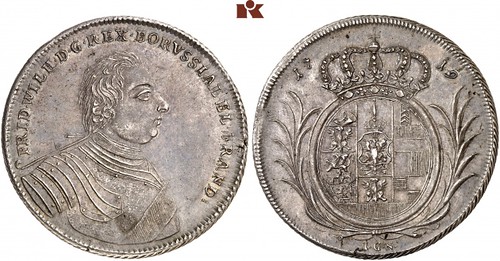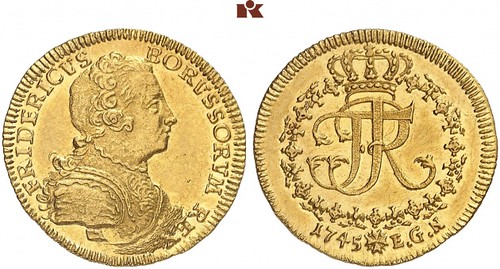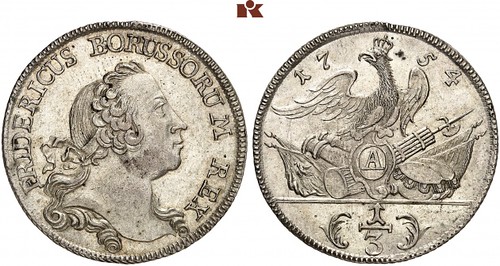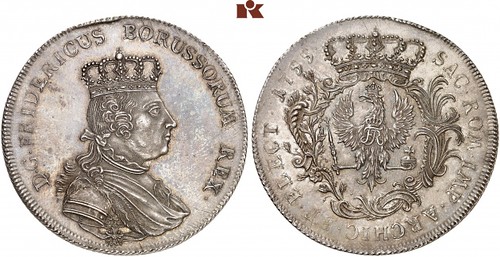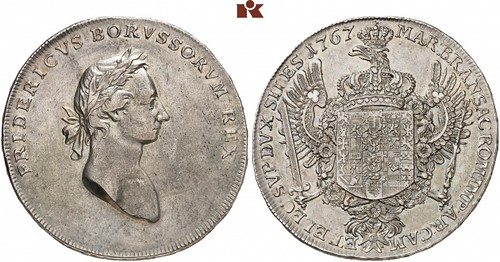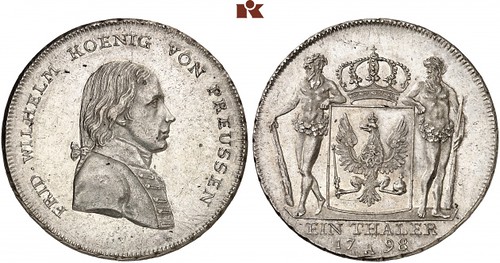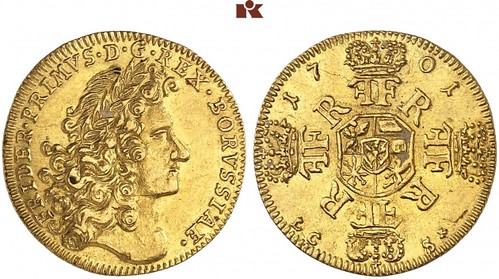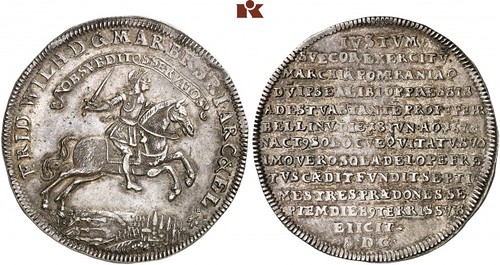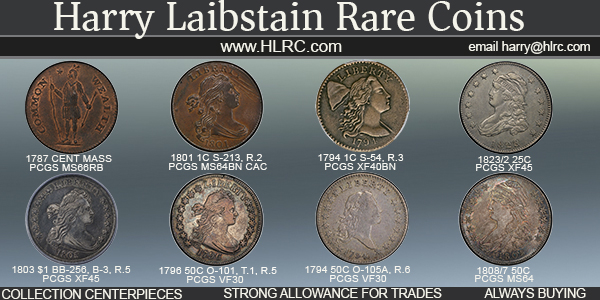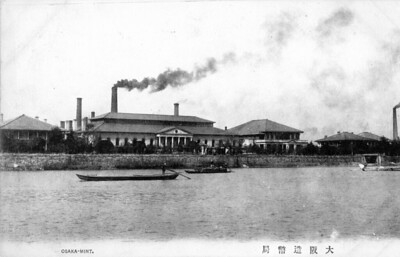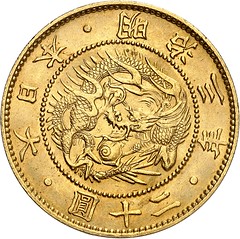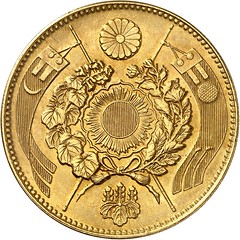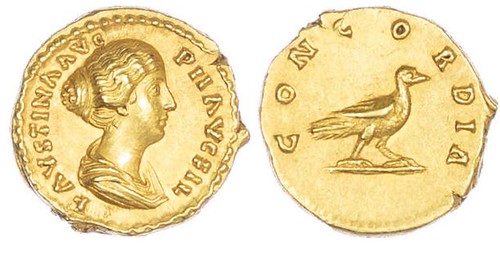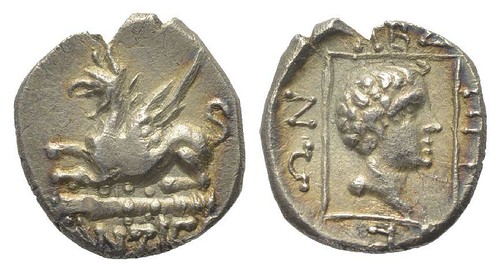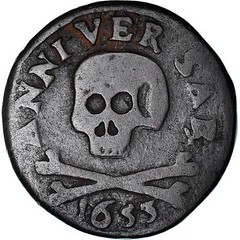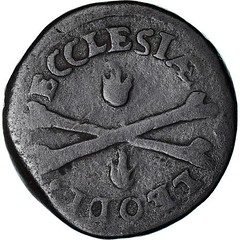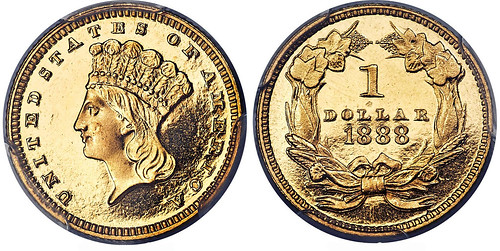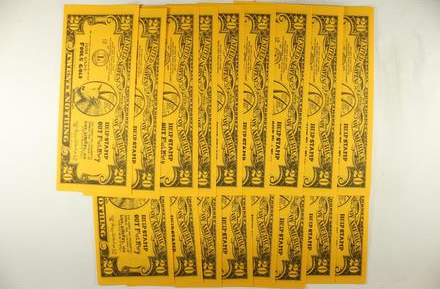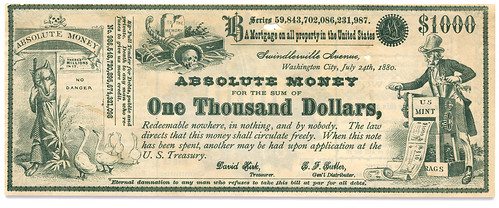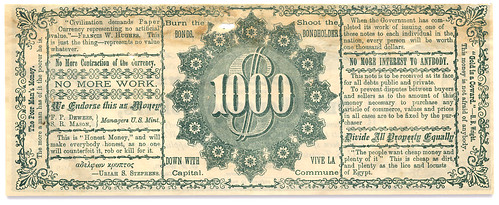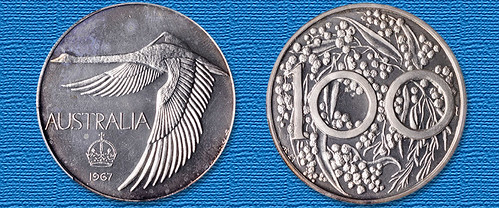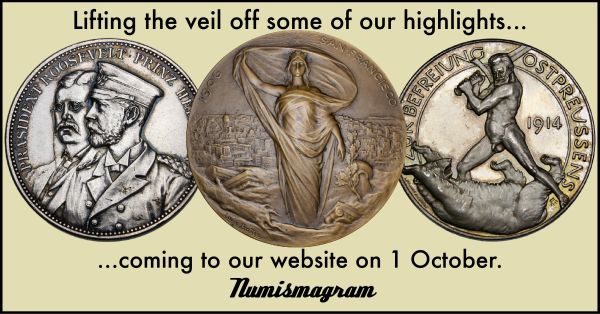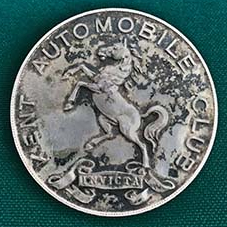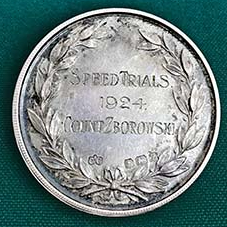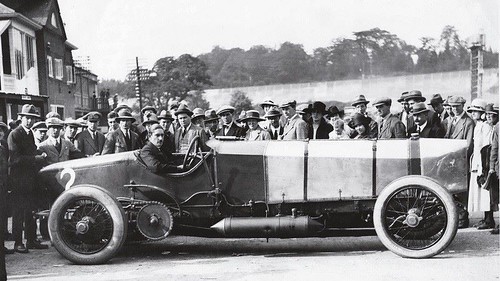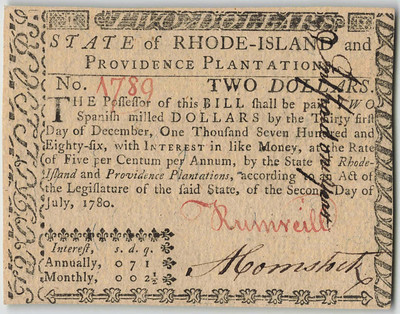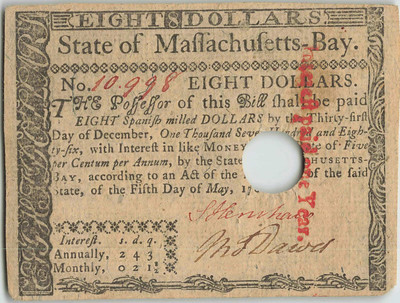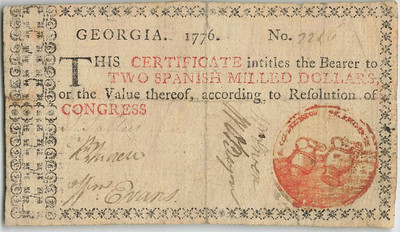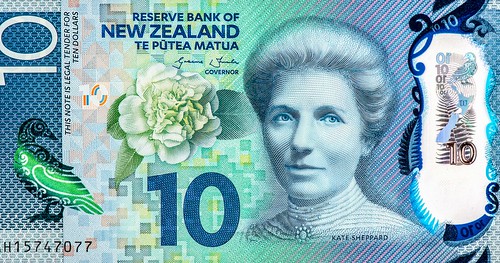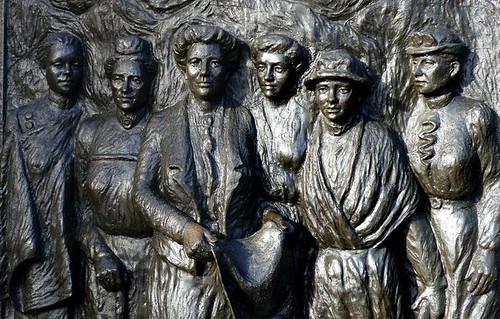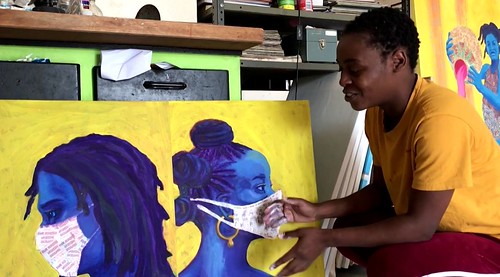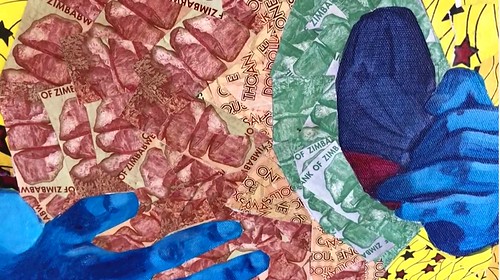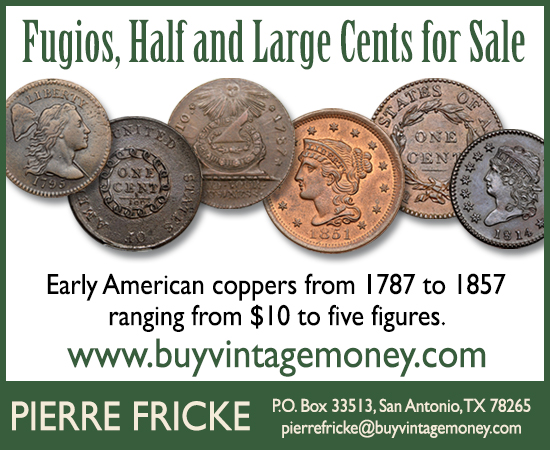
Visit our NBS Sponsors


About UsThe Numismatic Bibliomania Society is a non-profit association devoted to the study and enjoyment of numismatic literature. For more information please see our web site at coinbooks.org SubscriptionsThose wishing to become new E-Sylum subscribers (or wishing to Unsubscribe) can go to the following web page link MembershipThere is a membership application available on the web site Membership Application To join, print the application and return it with your check to the address printed on the application. Print/Digital membership is $40 to addresses in the U.S., and $60 elsewhere. A digital-only membership is available for $25. For those without web access, write to: Charles Heck, Treasurer AsylumFor Asylum mailing address changes and other membership questions, contact Chuck at this email address: treasurer@coinbooks.org SubmissionsTo submit items for publication in The E-Sylum, write to the Editor at this address: whomren@gmail.com BUY THE BOOK BEFORE THE COIN |
- WAYNE'S WORDS: THE E-SYLUM SEPTEMBER 19, 2021
- ANS OFFERS NUMISMATIC LITERATURE
- IAPN BOOK PRIZE 2020
- FRED L. REED III (1948-2021)
- NEWMAN EDITING MONEY IN EARLY AMERICA
- VIDEO: MEXICAN COPPER COIN BOOKS
- QUERY: MORSE CODE ON 2004 OLYMPIC COIN DESIGN
- COIN FOUND IN THE BELLY OF A COD FISH
- NEW YORK NUMISMATICS ON 9/11: STACKS
- NOTES FROM E-SYLUM READERS: SEPTEMBER 19, 2021
- BITCOIN TRADING AND STAMP COLLECTING
- "FOREVER COIN" IDEA
- VOCABULARY TERM: FIREGILDING, FIREGILT
- RITTENHOUSE HALF DISMES REENACTMENT ANSWER
- FORGOTTEN COIN BOARDS
- JOEL OROSZ 2021 BURNETT ANDERSON AWARD
- WAYNE'S NUMISMATIC DIARY: SEPTEMBER 19, 2021
- GEOFFREY BELL 2021 FALL SALE HIGHLIGHTS
- HIGHLIGHTS OF THE AXEL TESMER COLLECTION
- KüNKER OFFERS 1870 JAPAN 20 YEN
- NUMISMATIC NUGGETS: SEPTEMBER 19, 2021
- 1967 AUSTRALIA PATTERN DOLLAR
- ROYAL MINT RESUMES PENNY PRODUCTION
- CHITTY BANG BANG MEDAL
- US COLONIAL PAPER MONEY: AN INTRODUCTION
- NEW ZEALAND FEMINIST KATE SHEPPARD
- BOGGS, TUBMAN AND U.S. PAPER MONEY
- ZIMBABWE ARTIST TURNS NOTES INTO PAINTINGS
- WHEN THE WILD BUNCH FIRST GRABBED GOLD
Click here to read the thin version on the web
Click here to subscribe
Click here to access the complete archive
To comment or submit articles, reply to whomren@gmail.com
Content presented in The E-Sylum is not necessarily researched or independently fact-checked, and views expressed do not necessarily represent those of the Numismatic Bibliomania Society.
WAYNE'S WORDS: THE E-SYLUM SEPTEMBER 19, 2021
 New subscribers this week include:
Dr John Rainey, OBE, courtesy Peter Preston-Morley;
Michael E. Kenny, courtesy Ronan Fitzpatrick;
Eric Bradley, and
Inja MacClure.
Welcome aboard! We now have 6,706 subscribers.
New subscribers this week include:
Dr John Rainey, OBE, courtesy Peter Preston-Morley;
Michael E. Kenny, courtesy Ronan Fitzpatrick;
Eric Bradley, and
Inja MacClure.
Welcome aboard! We now have 6,706 subscribers.
Thank you for reading The E-Sylum. If you enjoy it, please send me the email addresses of friends you think may enjoy it as well and I'll send them a subscription. Contact me at whomren@gmail.com anytime regarding your subscription, or questions, comments or suggestions about our content.
This week we open with numismatic literature offerings from ANS, book awards from IAPN, updates from the Newman Numismatic Portal, and more.
Other topics this week include a "Forever Coin", firegilding, the Burnett Anderson Memorial Award, auction previews, the 1967 Australian pattern dollar, U.S. colonial paper money, J.S.G. Boggs and Harriet Tubman, and Butch Cassidy and the Sundance Kid.
To learn more about Confederate Treasury Notes, Swedish gold coins, Fred Reed, Dick Doty, Eric Newman, Ed Cogan, New York numismatics on 9/11, the Rittenhouse half dismes reenactment, two-faced Lincoln cent art, Where's George, a new coin for Japan, Swindleville Avenue, the Chitty Bang Bang medal, and the coin found in the belly of a codfish, read on. Have a great week, everyone!
Wayne Homren
Editor, The E-Sylum
ANS OFFERS NUMISMATIC LITERATURE
Don't forget that the American Numismatic Society has an ongoing sale of duplicates on eBay, and numismatic literature is included along with some great coins, tokens and medals. Here's a selection of some current book offerings. -Editor
Ex-ANS Library and ex-Bullowa copy of DIE DEUTSCHEN REICHSMÜNZEN VOM JAHRE 1871 BIS MIT 1898 UND BEZÜGLICHEGESETZE U.S.W.. Kummer, Alexander. Includes 8 pages of photographic coin plates. 1899.
To read the complete lot description, see:
Die Deutschen Reichsmünzen Vom Jahre 1871 Bis Mit 1898 (Ex-Bullowa)
(https://www.ebay.com/itm/133876274427)
Ex-ANS Library and ex-Bullowa copy of ÉTUDES HISTORIQUES ET CRITIQUES SUR LES MÉDECINS NUMISMATISTES, CONTENANT LEUR BIOGRAPHIE ET L'ANALYSE DE LEURS ÉCRITS. Renauldin, Joseph. Does not include any photographic coin plates. 1851.
To read the complete lot description, see:
Études Historiques Sur Les Médecins Numismatistes
(https://www.ebay.com/itm/133876272097)
Ex-ANS Library copy of GLI ORDINI EQUESTRI DEL REGNO D'ITALIA. Ceschina, Renzo Ermes. Brevi Cenni Storici. Statuti, Regolamenti, Insegne, Prerogative Dei Decorati, Ecc. Includes multiple illustrated coin plates throughout. 1938.
To read the complete lot description, see:
Coin Book - Gli Ordini Equestri Del Regno D'Italia
(https://www.ebay.com/itm/133876259100)
Ex-ANS Library and ex-Bullowa copy of DIE BRAKTEATEN DER GRAFEN VON MANSFELD, DER EDLEN HERREN VON FRIEDEBURG UND DER HERREN VON SCHRAPLAU. Tornau, O. Mit einer Karte, 3 Stammtafeln und 11 Lichtdrucktafeln. Includes 11 pages of photographic coin plates. 1940.
To read the complete lot description, see:
Coin Book - Die Brakteaten Der Grafen Von Mansfeld (Ex-Bullowa)
(https://www.ebay.com/itm/133876251063)
Ex-ANS Library and ex-Bullowa copy of CONFEDERATE TREASURY NOTES. Chase, Philip H. Confederate Treasury Notes The Paper Money of The Confederate States of America 1861-1865. Includes numerous photographic plates throughout. 1947.
To read the complete lot description, see:
Coin Book - Confederate Treasury Notes (Ex-Bullowa)
(https://www.ebay.com/itm/133870722678)
Ex-ANS Library and ex-Bullowa copy of LE MONETE DEI POSSEDIMENTI VENEZIANI. Lazari, Vincenzo. Le Monete Dei Possedimenti Veneziani Di Oltremare e Di Terraferma Descritte ed Illustrate. Includes 14 pages of illustrated coin plates. 1851.
To read the complete lot description, see:
Coin Book - Le Monete Dei Possedimenti Veneziani (Ex-Bullowa)
(https://www.ebay.com/itm/133870721002)
All auction listings are duplicates from the American Numismatic Society and are sold with that pedigree. Founded in 1858, the American Numismatic Society is dedicated to the study and public appreciation of coins, currencies, medals, and related objects. Ever since its foundation, the ANS has assembled a permanent collection, which currently has more than 800,000 objects dating from 2100 B.C. to the present, as well as a numismatic library with approximately 100,000 books, documents, and artifacts. These resources support the publication of books and periodicals, and the hosting of lectures, academic seminars, and exhibitions. Memberships start at $100 and include our quarterly magazine and access to online programs.
NO RESERVE. All auctions are listed without a reserve price. Items are packaged carefully to minimize shifting during transit. Handling time is three (3) business days from payment date, however most lots ship the following business day after payment is made. We will happily combine shipping where possible, please contact us if you would like to combine shipping for lots that end multiple days apart. Buyer should contact the ANS within 30 days upon receiving won lots to request a return; return shipping is the responsibility of the buyer, and the full lot must be returned. Listings are unique and cannot be exchanged.
IAPN BOOK PRIZE 2020
International Association of Professional Numismatists (IAPN) Publication Committee chairman Peter Preston-Morley submitted the following report on the 2020 IAPN Book Prize. Thank you, and congratulations to the winners and nominees. -Editor
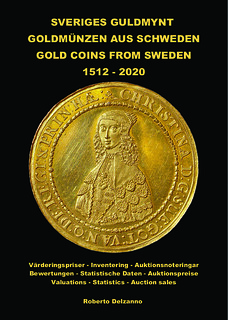 I am writing with news of the IAPN Book Prize for 2020, which was competed for last weekend at the organisation's much-delayed 2021 General Assembly, which was staged online via Zoom. The original contest was scheduled to have been held live, in Marseilles, in May 2020, but for obvious reasons associated with the pandemic had to be postponed.
I am writing with news of the IAPN Book Prize for 2020, which was competed for last weekend at the organisation's much-delayed 2021 General Assembly, which was staged online via Zoom. The original contest was scheduled to have been held live, in Marseilles, in May 2020, but for obvious reasons associated with the pandemic had to be postponed.
There were 16 nominations, as listed in the attachment. Of necessity, all books eligible had to have been published in 2019.
The clear winner was the Stockholm numismatist Roberto Delzanno, for his self-published 450-page catalogue, Sveriges Guldmynt 1512-2020. Placed second in the voting was the 200-page title by François Joyaux, Monnaies Impériales d'Annam, published by Editions V. Gadoury in Monaco. Third was the groundbreaking 2-volume study by British scholar Hodge Malek, entitled Arab-Sasanian Numismatic History during the Early Islamic Period in Iran and Iraq, published by the Royal Numismatic Society in London.
The prize, Swiss Fr 1,000, and a diploma, will be awarded to Mr Delzanno at a future date.
IAPN Book Prize 2020: Nominations
ABDY, Richard. The Roman Imperial Coinage. Volume II, Part 3, from AD
117-138. Hadrian.
Spink, London, 2019
978-1-912667-18-5
Price: GBP 150. Order from
www.spink.com
ANDREWS, Murray. Coin Hoarding in Medieval England and Wales, c.973-
1544.
BAR Publishing, Oxford, England, 2019
978-1-4073-5668-6
Price: GBP 61. Order from
www.barpublishing.com
BESLY, Edward. Coins and Medals of the English Civil War.
Spink, London/National Museum Wales, Cardiff, 2019
978-1-912667-01-7
Price: GBP 40. Order from
www.spink.com
DELZANNO, Roberto. Sveriges Guldmynt 1512-2020.
Roberto Delzanno, Stockholm, Sweden, 2019
ISBN 978-91-639-9466-1
Price: US $54.95. Order from
www.coin-currency.com
EVENSEN, Stein. Ancient Rome by Coins.
Orfeus Publishing, Oslo, Norway, 2019
978-82-93140-67-2
Price: NOK 400. Order from
www.oslomyntgalleri.no
FAULKNER, Christopher. Imperial Designs. Canada's Ships, Colonies &
Commerce Tokens.
Spink, London, 2019
ISBN 978-1-912667-11-6
Price: GBP 50. Order from
www.spink.com
HARITWAL, Deepak. Coins of the Princely State of Jaipur.
Deepak Haritwal, Long Beach, USA, 2019
ISBN 978-1-64713-468-6
Price: US $60. Order from
www.stevealbum.com
HILBERT, Rudolf. Die Elektronprägung von Milet. 2 vols.
Habelt Verlag, Bonn, Germany, 2018 [late 2018: only available to the market
in 2019]
ISBN 978-3-7749-4181-6
Price: €89. Order from
www.habelt.de
JENCIUS, Peter. Vatican City Coins 1929-1978.
Peter Jencius, Brooklyn, USA, 2019
ISBN 978-1-7342777-0-8
Price: US $34.99. Order from
www.vaticancoins.com
JOYAUX, François. Monnaies Impériales d'Annam.
Editions V. Gadoury, Monaco, 2019.
ISBN 978-2-906602-49-6
Price: €29. Order from
www.gadoury.com
LUX, Iván. Identification of Archduke Ferdinand II Tyrolean Thalers.
Iván Lux, Budapest, 2019 [hardback printing of book originally published in
2017]
ISBN 978-963-12-9506-1
Price: US $32. Order from
ilux0807@gmail.com
MALEK, Hodge. Arab-Sasanian Numismatics and History during the Early
Islamic Period in Iran and Iraq. 2 vols.
Royal Numismatic Society, London, 2019
ISBN 0-901-405-94-9
Price: GBP 95. Order from
www.spink.com
MOORE, Roger. The Coins of Colonial Virginia.
C4 Publications, Baltimore, USA, 2019
ISBN 978-1-64606-131-0
Price: US $95. Order from
www.numisbook.com
ROSS, Michael. Jacques Wiener's Most Remarkable Edifices of Europe. The
Man, Monuments, and Medals.
American Numismatic Society, New York, 2019
ISBN 978-0-89722-359-1
Price: US $100. Order from
www.numismatics.org
STEVENS, Paul. The Coinage of the Bombay Presidency. A Study of the
Records of the EIC.
Spink, London, 2019.
ISBN 978-1-912667-12-3
Price: GBP 60. Order from
www.spink.com
THÉRET, Philippe. Le Franc. Les monnaies, les archives.
CGB Numismatique, Paris, 2019.
ISBN 978-2-37909-000-4
Price: €59. Order from
www.cgb.fr
For more information on IAPN Book Prize, see:
https://iapn-coins.org/
https://iapn-coins.org/iapn/iapn-book-prize/
Paul Montz of Stephen Album Rare Coins adds:
"Readers might be interested in the candidates that were elected to IAPN membership at our virtual Congress:
- Amos Media
- CNG LLC
- Mariano Cohen
- Heritage Auctions
- Kolner Munzkabinett
- Lugdunum GmbH
- MDC-Monnaies de Collection
- Moruzzi Numismatica
- Shanna Schmidt Numismatic Inc.
- Vilmar Numismatics LLC
Congratulations to the new members, many of whom are E-Sylum contributors and supporters. -Editor
FRED L. REED III (1948-2021)
I was very sorry to learn recently that numismatic researcher and author Fred Reed has passed. Thanks to Benny Bolin, Cole Hendrickson and others who passed the word. Here's an article Benny provided from the current issue of Paper Money, the official publication of the Society of Paper Money Collectors. -Editor
Fred Reed passed away on Saturday, July 24
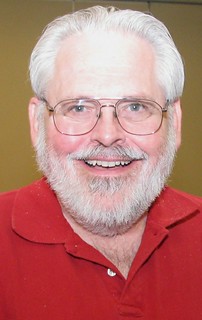 Fred L. Reed III was Honorary Life Member #24. An author, researcher, editor, Fred was indeed a stalwart in our hobby. He was born in Syracuse, NY and attended Oklahoma State University. He joined the Coin World staff in 1975 until he left in 1981. He took over and revitalized the SPMC's Paper Money as editor from 1999 to 2013. He also was editor of the TAMS journal. Besides serving as Editor Extraordinaire, he also served the society as Secretary, and served on the board of governors from 1998-2001. The society awarded him an Award of Merit in 2000 and the Nathan Gold award in 1996. He was named to the SPMC Hall of Fame in 2015. His career spanned many genres.
Fred L. Reed III was Honorary Life Member #24. An author, researcher, editor, Fred was indeed a stalwart in our hobby. He was born in Syracuse, NY and attended Oklahoma State University. He joined the Coin World staff in 1975 until he left in 1981. He took over and revitalized the SPMC's Paper Money as editor from 1999 to 2013. He also was editor of the TAMS journal. Besides serving as Editor Extraordinaire, he also served the society as Secretary, and served on the board of governors from 1998-2001. The society awarded him an Award of Merit in 2000 and the Nathan Gold award in 1996. He was named to the SPMC Hall of Fame in 2015. His career spanned many genres.
He was the writer/editor in the baseball card field and served as VP with Beckett Publications. His books included Civil War Encased Stamps: The Issuers and Their Times published in 1995 as well as a book on a related topic, Civil War Stamp Envelopes: Their Issuers and Their Times. With many irons in the fire, Fred was an avid researcher on Abraham Lincoln culminating with his book Abraham Lincoln: The Image of His Greatness published in 2009 followed by Abraham Lincoln: Beyond the American Icon published in 2013. He authored Show Me the Money: The Standard Catalog of Motion Picture, TV, Stage, and Advertising Prop Money published in 2005. He was the author of a Numis-mystery
series from 1976-1977, and The Week that Was and Spare Change columns in Coin World. A very prolific writer, Fred contributed many articles to Bank Note Reporter, Coin World and Numismatic News to name a few publications.
It was indeed a shock to learn of Fred's passing. I always counted Fred as a friend and mentor. He helped me learn the ins and outs of writing a good article. I was proud to be a contributor to a couple of his books.
Mark Anderson, past President and Treasurer and current member of the BoG of the SPMC remembers Fred; Fred was an unusually perfect fit for the SPMC's journal AND his role in its executive. He arrived at a time of desperate need, and righted Paper Money's seriously listing ship immediately and professionally, getting us back on schedule and fulfilling our key obligation to our members. But he didn't stop there. Over time, he increased the size of the magazine, took it into the age of color, and made anniversary issues true celebratory events.
Fred was a true collector, and his personal publications, about movie money and Lincoln, reflected this. He introduced and championed the SPMC Hall of Fame, and was always a creative, engaged force at the board meetings and in the stewardship of the SPMC.
At the same time, he was intensely private, and we all wished he had a phone, but over time I came to understand how that choice worked for him, and allowed his intensely productive operating style. The arrival of his debilitating stroke could never have been untimelier. We lost an active, vibrant participant in our passion and our lives. We all owe him.
Wendell Wolka, past President (et.al.) and current member of the BoG remembers Fred; I was fortunate to count Fred Reed as a friend and mentor. He was a capable and talented editor and publisher and was instrumental in bringing the Society through a rough patch when the magazine had not been published for a rather large number of issues a number of years ago. He did all this and more without fanfare and was the consummate gentleman who believed in doing the right thing the right way every time. God bless.
Pierre Fricke also a past President and current member of the BoG as well as a currency dealer says: Fred was one of the great researchers, historians, and leaders of our numismatic, Lincoln and other history. I had the honor of co-authoring a book with him on the History of Collecting Confederate Paper Money and his research, writings and advice was invaluable. He has made a great contribution to our hobby and our understanding of our history! I miss Fred greatly and only hope I can carry on his work in my work to the degree he would find enlightening and interesting.
Frank Clark also remembers Fred: I cannot remember when I met Fred Reed, but it was long ago in the 1980s as we both lived in Dallas and saw each other quite often at the local shows and coin clubs. We began to run into each other at a once monthly Sunday only stamp show that was near my mother's house in the early 1990s. It was at this time that I learned that Fred lived near my mother and in fact he lived about halfway or roughly six miles between my house and my mom's. Later when I became president of SPMC in 1999, this fact proved very beneficial as I could visit with Fred either on my way to or on my way home from my mom's.
After Gene Hessler stepped down as editor of Paper Money, SPMC lacked an effective editor and the publication of our bimonthly journal fell greatly behind and several members wondered if SPMC had disbanded.
Fred volunteered to serve as editor and I spent a lot of time over at his house helping to get the back issues of Paper Money out. Due to Fred, SPMC went from not publishing a single issue of Paper Money for many months to sending a new journal every few weeks to the membership until we were caught up. Then, Fred started working on our large 40th anniversary issue of Paper Money, which had 160 pages and a massive amount of information on the society.
Treasurer Mark Anderson was so impressed with our hard (well mostly Fred's) work that he had made up for each of us a special award consisting of a model railroad car on a train track attached to a base with a name plate that stated the "Back on Track Award." Fred and I were very moved by this award. Every time I look at the award, I think about those days and evenings getting Paper Money "back on track." SPMC owes Fred a big "thank you" and "job well done." It is the friendships that make our hobby so great.
I met Fred Reed back in the 1980s and became a research assistant for him, helping locate information for the Civil War Encased Stamps book. We corresponded a lot as I tracked down information from the New York Public Library to Princeton University. I was able to hold John Gault's original patent drawing in my hands - the thrill of a lifetime for a collector of Encased Postage Stamps. It was a shock to learn about his sudden stroke. He's already been missed for years - he was the most prolific, hard-working researcher and writer I've ever known, perhaps short of Dave Bowers. Rest in peace, Fred; Thanks so much for all you've done for the hobby. -Editor
Cole Hendrickson writes:
"While my entrance to numismatics occurred after he was sidelined by illness, his research on Civil War numismatics has been a major influence for me. His book on encased postage is one of my favorite numismatic books of all time and I hope that someday his goal of A Numismatist's Perspective of the Civil War
will be realized. His passing is a major loss to the numismatic community and I would like to offer my deepest condolences to his family."
To read the earlier E-Sylum article, see:
AUTHOR FRED REED SIDELINED BY ILLNESS
(https://www.coinbooks.org/esylum_v17n04a03.html)
NEWMAN EDITING MONEY IN EARLY AMERICA
Newman Numismatic Portal Project Coordinator Len Augsburger provided the following story of scholar Eric Newman's work ethic. Thanks. -Editor
Dick Doty and Eric Newman Dress Down for Numismatic Research
The renewal of the ANS Coinage of Americas Conference, with this week's conference focusing on Victor D. Brenner, brings to mind the forerunner of the COAC series, the 1976 volume Studies on Money in Early America. This work, edited by Richard Doty and Eric Newman, gathered scholarly papers on American numismatics. At an ANS tribute dinner held for Newman in 1996, Doty contributed the following anecdote surrounding production of the 1976 volume:
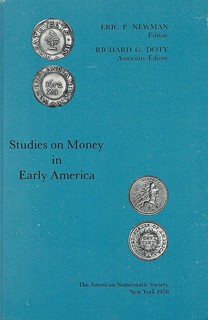
It took place over twenty years ago, in Los Angeles, during the summer of 1975. Eric and I were both at the convention of the American Numismatic Association, held that August. Eric was there to give several lectures and receive an award. I was there to set up and oversee an ANS exhibit, my first, and we were both there to work on the editing of the Society's upcoming publication for the American Bicentennial, Studies on Money in Early America.
"We agreed to assemble in Eric's hotel room one day about noon. Most of the articles gave us few difficulties, but there was one... It was by an elderly gentleman who knew an immense amount about his subject, but had no idea of how to render its telling into understandable prose. Eric and I worked on that article, and worked, and worked - and made absolutely no progress. Then the air-conditioning in Eric's room abruptly went on strike, and our workplace rapidly heated up; within an hour or so, it was ninety-five.
"I asked Eric whether we should simply give up, abandon the attempt to edit the recalcitrant article - or at least defer it until the air-conditioner was repaired. But Eric was a stubborn man: he knew that article was worth saving because of its scholarly value, because of the fact that the writer was a friend of many years' standing. He suggested that we make ourselves as comfortable as we could, and keep on working. And so an impartial observer would have seen two gentlemen in their underwear, fortified with luke-warm beer [this must have been Doty only, because Newman did not drink], taking apart an article and putting it back together again, word by word. I have never had a more arduous editing task, nor, I imagine, has Eric. But as I worked with him through the afternoon and into the evening, I gained an admiration of tonight's honoree which has never left me. This man would expose the best, would bring to light the work his friend wanted to write - and would do it in such a way that the latter would believe he had written it himself.
"And that act of scholarship and humanity sums up my friend, Eric P. Newman.
Link to ANS Coinage of Americas Conference proceedings on Newman Portal
https://nnp.wustl.edu/library/publisherdetail/510766
VIDEO: MEXICAN COPPER COIN BOOKS
These are selections from the David Lisot Video Library that feature news and personalities from the world of coin collecting. David has been attending coin conventions since 1972 and began videotaping in 1985. The Newman Numismatic Portal now lists all David's videos on their website at:
https://nnp.wustl.edu/library/multimediadetail/522852
Here's one on new Mexican Copper coin books at the 2021 Texas Numismatic Association Convention. See last week's articles for additional information. -Editor
Books on Mexican Copper Coins Available at Texas Numismatic Association 2021.
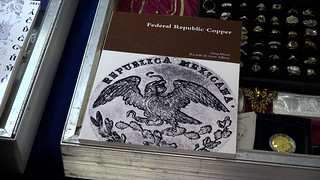 June 5, 2021. Greg Meyer, Numismatic Author, David Lisot Interviewer, CoinTelevision.com.
June 5, 2021. Greg Meyer, Numismatic Author, David Lisot Interviewer, CoinTelevision.com.
Greg Meyer has written three books about Mexican numismatics including The Republic One Centavo, Federal Republic Copper, and Zacatecas State Coppers. He shows each book and shares the information contained.
An excerpt of the video is available for viewing on the Coin Television YouTube Channel at:
https://youtu.be/6NSXlzVZInU
To read the earlier E-Sylum articles, see:
NEW BOOK: FEDERAL REPUBLIC COPPER
(https://www.coinbooks.org/v24/esylum_v24n37a04.html)
NEW BOOK: ZACATECAS STATE COPPERS
(https://www.coinbooks.org/v24/esylum_v24n37a05.html)
QUERY: MORSE CODE ON 2004 OLYMPIC COIN DESIGN
John Regitko of Toronto submitted this question about a rejected Canadian coin design for a 2004 Olympic Games commemorative. -Editor
Regarding the differences in the Morse Code/International Code variables, I wonder if Peter Jones can advise me on the following:
My upcoming new book tentatively entitled "In Search of a Design" will show a number of rejected designs of themes that were selected for Canadian commemorative coins, as well as illustrations of designs of themes that were also under consideration but ultimately rejected.
One of the rejected submissions was for the 2004 Olympic Games held in Athens containing what I assumed was Morse Code.
However, when I start at the top of the rim to the right of the maple leaf, I get "TRANSLORTATION COMMUNICATION."
The sixth letter is a L instead of a P.
My draft write-up is: "The above illustration of Taylor's design includes the International Code (more commonly known as Morse Code, although there were actually three people involved in its creation and was later revised by Alfred Vail when it became known as the American Morse Code)."
But in view of the last E-Sylum, I thought I better check. Please ask Peter to confirm or correct.
Incidentally, if the Code on the rejected submission is indeed wrong, I am sure the product manager at the Royal Canadian Mint would have caught it.
I still wonder why Raymond Taylor, a very successful Canadian coin designer, would think this is an appropriate design for a Canadian coin just because it has a small Maple Leaf at the top.
Peter Jones writes:
"I agree the token illustrated reads TRANSLORTATION COMMUNICATION in regular Morse code. I would rephrase John's paragraph on Morse as follows."
"Samuel Morse originally intended only a sequence of numbers which the receiver of the code would look up in codebooks for their meaning as letters.
"In 1840 Alfred Vail expanded the code to include letters, which became standardized in 1844 for railroad telegraphy, also called railroad Morse. Friedrich Gerke in Germany changed it in 1848, eliminating spacing within letters, allowing only dots and dashes.
"Then in 1865, the International Telecommunication Union changed the code again to account for different letter frequencies, which is the Morse code we know today."
To read the earlier E-Sylum article, see:
NOTES FROM E-SYLUM READERS: SEPTEMBER 12, 2021 : The Chubbuck Telegraph Token and American Morse Code
(https://www.coinbooks.org/v24/esylum_v24n37a15.html)
COIN FOUND IN THE BELLY OF A COD FISH
Gary Oddie writes:
"Following recent notes in The E-Sylum, I have just put together a short note for the British Numismatic Society blog about a shilling found in the stomach of a cod fish in 1773."
Cool - thanks. Here's an excerpt, but see the complete article online for more. -Editor
Recently two notes have appeared on the E-Sylum about coins that have been found in the stomachs of fish. The first referred to an English seventeenth century token found in the stomach of a five-foot shark caught off Galveston, Texas in 1931.(1-4) The token was a farthing issued by Richard Langley of Ramsgate, dated 1657.
The second relates that on June 15, 1842, a shark caught off the Isle of May (in the Firth of Forth) was bought by fishmongers G. Dickson & Co at Edinburgh market. Inside was found a tin box containing various British and foreign coins and tokens with dates ranging from 1671-1811. The tin box must have been water-tight and stomach proof as it also contained an old map of Scotland by Jeffrey and some newspaper cuttings!
To these can be added the following piece.
Obv. FOUND•IN•THE•BELLY•OF•A•CODFISH •1773• around 18 MARCH BY T•HENDRY LYNN neatly engraved.
Rev. Peined flat with countermarks FISH and FI (distorted by the peining), with faint traces of AG and R•F of the host coin legend.
Details. Ag, 26.8 mm, 5.218 g, no trace of edge graining showing. 150%.
Notes. Using the remnants of the reverse legend to orientate the piece it is possible to just see the faintest of outline of a bust of in the toning on this William III shilling. [GO, Ex F. Pridmore 1970s, and D. Young 2006].
Known locally as Lynn, King's Lynn is a port and market town in the west of Norfolk. It was mentioned in the Domesday Book as having salt evaporation ponds and was known as Bishop's Lynn until the dissolution of the monasteries when it was given to Henry VIII by the Bishop of Norwich in 1536.
To read the complete article, see:
Fishy Tales from King's Lynn – Gary Oddie
(https://britnumsoc.blog/2021/09/19/fishy-tales-from-kings-lynn-gary-oddie/)
To read the earlier E-Sylum article, see:
MORE SHARK STOMACH COIN FINDS
(https://www.coinbooks.org/v24/esylum_v24n36a07.html)
NEW YORK NUMISMATICS ON 9/11: STACKS
Harvey Stack submitted these remembrances of September 11 and its effect on their New York-based numismatic business. Thanks! -Editor
A "9 - 11" NUMISMATIC STORY FEW KNOW ABOUT
 Stack's planned in 2001 to have an important public
Auction sale in September, to be held on September 12, 13 in New York. The
coins were to be consigned by our close friend and collector, and important teacher,
Cornelius Vermule, who was the numismatic director of the Boston Museum of Fine Arts and
the Massachusetts Historical Society, who collected and taught Greek and Roman history,
and also had a great interest in the coinage of the Far East. His collection was one of the
most worthy in the various fields he amassed.
Stack's planned in 2001 to have an important public
Auction sale in September, to be held on September 12, 13 in New York. The
coins were to be consigned by our close friend and collector, and important teacher,
Cornelius Vermule, who was the numismatic director of the Boston Museum of Fine Arts and
the Massachusetts Historical Society, who collected and taught Greek and Roman history,
and also had a great interest in the coinage of the Far East. His collection was one of the
most worthy in the various fields he amassed.
Since the Stack family, all of us, were very close friends of "Bucky" (his nick-name given to him by his very close friends and colleagues), we felt it would be appropriate to offer his collection in our early fall sale. September was selected, as it would be close to the Summer ANA convention, and many of our overseas clients would still be traveling about the United States and would schedule to examine the collection, plan to attend and/or leave bids. The dates of the sale were to be after Labor Day that year, and we selected the sale dates of September 12, 13. A super illustrated catalog was prepared and we planned a long pre-sale exhibition time to gather the best audience we could.
The Stack family in 2001 all lived on Long Island, about 40 minutes from our offices. Those members of the family included myself (Harvey), Larry, my son, my wife, Harriet, and my daughter Susan. We all drove together in one car, carrying with us our personal luggage for several nights stay, had hotel rooms reserved for our staff, and left early in the morning to be ready to serve the viewers and dealers who came to New York before the sale and planned to view the lots on September 11 and 12. Others arrived before and our pre-sale viewing audience was immense.
We traveled through the borough of Queens on our way to the bridge crossing the Harlem river, to Manhattan, then to the westside drive along the Hudson to downtown New York.
As we began crossing the bridge, a flash came over the radio, that a plane struck one of the twin trade towers, and people were trying to leave the building. Thousands were therein employed and many died in the fire and collapse. Shortly thereafter the second tower was announced as also hit by another passenger plane, again engulfing the buildings in more fire and falling debris. The reports were horrifying. And the Stack family was still crossing the bridge to Manhattan and the westside drive, people were running out into the streets, not even knowing where they were going. All were bewildered and kept looking up to see if more aircraft might be coming their way. Once on 155th street we passed the courtyard where the American Numismatic Society had its museum and library for many decades. We then turned south on Broadway for some blocks.
We were able to turn east on 86th street and then when we reached Broadway we were directed south again as the full length of Central Park would block us from proceeding east. We continued down Broadway, past Lincoln Center in the 60's and on to Broadway again and found ourselves within a few blocks of 56th street where we had a reserved place for our car in a garage located between 7th avenue and the Avenue of the Americas (the old 6th Avenue) and pulled into our garage. Taking our bags with us, we went next door to the Parker Meridian Hotel which had entrances on both 56th street and 57th street, directly across the street from our offices at 123 West 57th street. It was a joy to see, the window gates were still down, no signs of vandalism, our armed guard standing before the entrance. We at least made it to our "home away from home !!!
We went through the lobby of the Hotel Salisbury (our landlord). l opened the shop at its side door in the hotel lobby, went to give the alarm response (but it wasn't working), turn on the lights, only some were functioning and realizing the air conditioner won't function without full power. We listened further to the radio (battery operated), and learned of a third plane that hit the Pentagon and a fourth crashed in Pennsylvania. Nobody knew if more were coming, where they came from and what was the immense damage and personal loss at the Trade Center. But we and a few of our staff who made it by subway or bus service made it to the shop.
Larry and I reviewed the entire situation as it occurred, and realized that those traveling by plane or train, or driving in cars, would have difficulty in making it to New York to look at the lots or attend the sale.
What to do? We decided to cancel the sale!!! Most businesses in New York did likewise, and so the city was no doubt still a target and those coming or there already would not be safe. We decided we could re-issue the catalog, and run the Cornelius Vermuele sale in November, if all that occurred a day before the sale calms down.
When the phones rang, we announced sale canceled!!!! When those in the city walked by we had to announce sale canceled. The internet was given the same announcement. With the over 700 sales that Stack's catalogued and conducted from 1935 to 2001, this would be the very first one we ever had to cancel. It was surely the right thing to do.
[For the numismatic record the day that John Kennedy was shot and killed in Dallas in1963, we had a similar decision to make. Would it be unpatriotic to have a sale on this tragic day??? Not having the answer, one of our great cataloguers, James C. Risk, who served in the Navy during World War II and who later was a diplomat to England, called on our behalf a close friend at our State Department to ask if this was unpatriotic. The answer came back that since the event was scheduled prior to the date of the assassination, and people had traveled or were already in attendance for that evening's sale, they recommend that the leader of the event (the auctioneer in this case) before the sale starts ask the audience to stand in silence, offer a prayer, and remain calm and thoughtful for about two minutes) and then let the auction proceed.
I, Harvey G. Stack, was the auctioneer of record for that sale. I made the appropriate announcement, had all stand in silence for over two minutes. And then started to offer the first lot for sale. It was such an emotional moment for me and those who participated in the sale, that I stuttered calling the first lot, which sold very slowly and eventually went to a floor bidder. The next four or five lots I sold, I also was stuttering, but got the lots sold. Once the emotional wave left me, I successfully conducted the balance of the lots to be offered that evening. As a professional auctioneer these first lots were the hardest I ever sold, but I am certain you can understand the emotion I felt that evening. ]
Now back to the evening of 9 - 11. To get food was the next chore. Most restaurants had closed, some even boarded up (expecting looting), and with power failures occurring sporadically, phone service disrupted, and delivery services stopped cold, all went for the best survival they could do and also try to get home. We fortunately had a very good Greek restaurant on our street and all got something to eat, in small groups, and tried to get into our hotel rooms. Another difficult job. If you were on a lower floor you could walk up - if not, our Hotel Salisbury got their staff to bring a few cots into our offices even though the air conditioning was faulty so we each took turns walking out our side door to get fresh air in the street (it was a hot and humid night but we endured.
We could not leave the shop for our alarm system wasn't working, and if someone broke in it could have been a disaster . On September 12th things started functioning again, the radio kept us up to date about the collapse at the World Trade Center, the Pentagon hit and the Pennsylvania crash. The news was terrible. During our stay at the office, we had our own Holmes armed guard watching that no one tried to break in, the alarm company made some temporary connections to our holdup system, but the electricity was still in an "on & off" state, the telephones and the lights the same, and most of our electronic equipment still not functioning. We were there but virtually in a "stand and wait for further assistance mode !!!
A few restaurants that had power re-opened and we could get some breakfast, and a few sandwiches for lunch. On the day after the attack, we learned that one of our favorite steak houses a few blocks from our offices was opened, so I took the few girls that were still with us, my family and went to the famous Ben Benson's to try to get a good meal after our recent ordeal. Their refrigeration seemed to function so most of us had a sea food cocktail, a steak or lamb chops but no bread. Because of the attack, no real food deliveries came into Manhattan. Because of bomb threats no trucks could make it. So we all had crackers and were thankful for them !!
On September 13, two days after the attack, our electricity went full power, our phones functioned, the air conditioning worked (this was still very hot and humid summer weather for New York but, however, the city seemed to get back to some order). Police patrol cars, EMS vehicles and fire apparatus continued to patrol the streets at close intervals to each other.
Stack's survived the crisis, our clients all thanked us for canceling the sale. Fortunately shortly thereafter our offices were back in full gear. The whole affair still gives me chills and hoping we do not ever have to endure a period like 9-11.
To read the earlier E-Sylum article, see:
THOUGHTS ON THE ANNIVERSARY OF 9/11
(https://www.coinbooks.org/v24/esylum_v24n37a16.html)
THE BOOK BAZARRE
NOTES FROM E-SYLUM READERS: SEPTEMBER 19, 2021
Sidey,
not Lidey
Mike Nixon of
Pearland, TX writes:
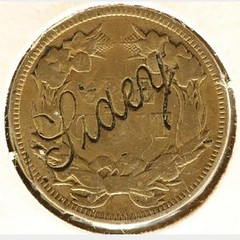 "I saw the bit on the counterstamped 1857 Flying Eagle in the most recent E-Sylum. Just so happens my collecting specialty is
"I saw the bit on the counterstamped 1857 Flying Eagle in the most recent E-Sylum. Just so happens my collecting specialty is Flyers,
including a number of counterstamped examples I've picked up over the past few years, they're fascinating and hard to find like you mentioned. Had never heard of the auction company, but signed up and bid on the coin and won it for $118, about mid-range for what I've paid for others.
It's definitely Sidey,
not Lidey,
but the stamp is not listed in either Brunk's Merchant and Privately Countermarked Coins
(2003) or Rulau's U.S. Merchant Tokens 1845-1860
(1982), nor have I found any other information with internet searches.
Just another benefit of subscribing to The E-Sylum! "
Glad to help. It's not the first time someone has reported purchasing an item featured in The E-Sylum. I know many specialist chat boards have a taboo on mentioning for-sale items, so as not to spoil potential cherry-picks. Not here. Anything available for public sale is fair game for discussion, from major auction house lots to obscure eBay offerings. I find them the same way everyone can now, from free seller email newsletters to saved Internet searches. -Editor
To read the earlier E-Sylum article, see:
NUMISMATIC NUGGETS: SEPTEMBER 12, 2021 : Flying Eagle Cent Counterstamp / Love Token
(https://www.coinbooks.org/v24/esylum_v24n37a26.html)
Tempest Over a Cheater's Weight
David Hendin passed along an article he published for CoinWeek about a misunderstanding over a recently discovered weight used for trading in ancient Jerusalem. While we often discuss discoveries like this, we hadn't published this one. Below is a link to a Jerusalem Post article, one of the first to mention the "cheating" theory. -Editor
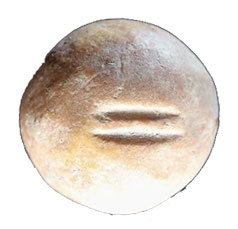 A scientist need not be chastised for every error. Neither should every archaeologist, numismatist, or historian. But when the error leads to lots of publicity and an internationally noticed erroneous report, it at least needs to be corrected. This is the case regarding a Judahite First Temple Period limestone scale weight discovered in Jerusalem but completely misunderstood by the authors who reported it.
A scientist need not be chastised for every error. Neither should every archaeologist, numismatist, or historian. But when the error leads to lots of publicity and an internationally noticed erroneous report, it at least needs to be corrected. This is the case regarding a Judahite First Temple Period limestone scale weight discovered in Jerusalem but completely misunderstood by the authors who reported it.
The professors concluded that because the weight in question had two parallel lines || that it represented the denomination of two gerahs, but fraudulently created to be MUCH heavier.
Unfortunately, the fraudulently
marked weight at the center of the story was not fraudulently marked at all.
To read the complete article, see:
Tempest Over a Cheater's Weight
(https://coinweek.com/ancient-coins/tempest-over-a-cheaters-weight/)
To read the Jerusalem Post article, see:
Weight used to cheat in trade during First Temple era found in Jerusalem
(https://m.jpost.com/archaeology/weight-used-to-cheat-in-trade-during-first-temple-era-found-in-jerusalem-678446/amp)
Numismatic Book Cover Idea
Regarding the popular "Money Changer" image seen on multiple book covers,
Ron Haller-Williams writes:
"The first image is "The Money Changer and His Wife" by Quentin Matsys (1514). The other one (and detail from it) are the version by Marinus van Reymerswaele (1538). I haven't yet seen anybody use Reymerswaele's "Two Tax Collectors""
That's a good one, too. Thanks, Ron. I was about to say "If anyone uses this for a numismatic book in the future, you saw it first here in The E-Sylum." But then Ron came across this exhibit catalog. -Editor
"Der Fürst als Sammler, Neuerwerbungen unter Hans-adam II. von und zu Liechtenstein"
("The Prince as a Collector, new acquisitions under Hans-Adam II von und zu Liechtenstein")
To read the earlier E-Sylum article, see:
NOTES FROM E-SYLUM READERS: SEPTEMBER 12, 2021 : More Duplicate Money-Lender Image Book Covers
(https://www.coinbooks.org/v24/esylum_v24n37a15.html)
Edward Cogan Token
Dave Hirt writes:
"I enjoyed reading the post on Edward Cogan. He was an interesting person. Reading about his controversy with dealers Colvin Randall and Ebenezer Mason made me think of a token about him. It was created by 19th century numismatist I F Wood. It starts with "Yours Faithfully". This was the way Cogan always closed his correspondence. Then a verse, with some words humorously spelled. "A FOINE OULD BROOKLYN GINTLEMAN OF A PEPPERY TURN OF MOIND. HE GETS HIS EBENEZUR UP AND THEN HE GOES IT BLOIND" This to me, describes the personality of Cogan. The token is Rulau ny-bk 7"
Pete Smith kindly provided an image of this rare medal from his collection. Thanks! -Editor
To read the earlier E-Sylum article, see:
EDWARD D. COGAN (1803-1884)
(https://www.coinbooks.org/v24/esylum_v24n36a12.html)
A Long-Sought Word: Pica
In our August 22, 2021 issue Carol Bastable described a new item in her collection. -Editor
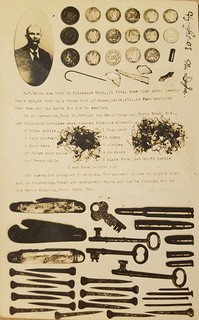 It is a 1908 postcard about a man that most likely had a condition known as pica. People with pica eat non food items. Less harmful materials might include the consumption of dirt or paper but there are more severe instances where people consume metal and even glass as this person did. Of numismatic note are the 14 dimes (one being Canadian) and three nickels that were surgically removed from this man's stomach. This is a poor example of how to start a coin collection.
It is a 1908 postcard about a man that most likely had a condition known as pica. People with pica eat non food items. Less harmful materials might include the consumption of dirt or paper but there are more severe instances where people consume metal and even glass as this person did. Of numismatic note are the 14 dimes (one being Canadian) and three nickels that were surgically removed from this man's stomach. This is a poor example of how to start a coin collection.
Contributing factors for pica can include nutritional deficiencies, stress, cultural influences, and even pregnancy.
Joe Barnosky of Camden, Michigan writes:
"Many thanks to you and Carol for publishing this topic matter. This answers questions I have been pursuing for decades by whatever means I could imagine. Many tried and true methods including variations on themes from "to do dictionary for one's self" to dream journals, to aggressive coin and other collecting to, indeed, numismatic bibliomania.
"Again and again, I have found the issue that plagues has been something from the era one would call "sins of the father", and that knowing one's immigrant ancestors were far more likely involved in omission than much else, their English language skills found wanting. Further, the prime suspect for problems in the language is again and again: homophony.
"Transcending "the farmer who was out standing is his field" has to be easier than to sponsor the Coffee Break Awards.
"Even if the words are not strictly homophones, the issue is sufficiently addressed as being "of homophony." At multiple languages, this is potentially a huge issue reduced to one word, and yes, I spent the years enough on the Russian vocabulary to know it.
"But now, it's back to plain English and what word is likely not found in my 1500+ volumes? Why recurring dreams for decades of eating horrible things such as bird's nests or glass? What's wrong with the cat this time? Of course I still keep my mother's Smith-Corona typewriter, what of it?
"Fell behind and reading 13 issues of The E-Sylum in a row.
"Pica. P-I-C-A. Numismatic bibliomania pays off.
"Thank you for being "word lovers too." I'm reduced to tears of appreciation."
Glad to help a fellow word lover. -Editor
Carol writes:
"It is hard to believe that my submission had such a profound impact on one person, with it ending a decades long search. I think I first heard the term 'Pica' on one of those medical show series. It may have been on Grey's Anatomy where a person swallowed plastic doll heads. There may have been another episode where a person swallowed metal objects but that was probably on a different series. I also liked the series House and learned a lot from that show. You never know when you file interesting tidbits of information away when and where you will draw on that information. For me, this postcard brought back some of the medical knowledge I had learned. I am glad I was able to share it."
To read the earlier E-Sylum article, see:
STOMACH COIN FINDS
(https://www.coinbooks.org/v24/esylum_v24n34a12.html)
BITCOIN TRADING AND STAMP COLLECTING
Carol Bastable passed along this item about Bitcoin from a September 13, 2021 Investing Daily email. -Editor
Crypto Trading Akin to Stamp Collecting
Finally, El Salvador may have embraced Bitcoin (BTC) as a national currency, but across the Atlantic, cooler heads prevail.
In fact, cryptocurrencies across the board took a header on Friday after the governor of Sweden's central bank pointed out Bitcoin's actual worthlessness.
"Private money usually collapses sooner or later," Riksbank Governor Stefan Ingves said. "And sure, you can get rich by trading in Bitcoin, but it's comparable to trading in stamps."
Carol adds:
"I got a chuckle when it said trading in Bitcoin was like trading in stamps. I think there has been some rivalry between coin and stamp collectors through the years with each thinking their own hobby is the preferable one.
"I just so happened to run across an old 1884 advertisement when stamps could be used in lieu of coins to purchase some items from mail order companies. Apparently it was also standard to mail money. I thought this was a nice contrast to the Bitcoin article with stamps as money....a sort of then and now."
"FOREVER COIN" IDEA
Wayne Pearson passed along an unusual coinage concept. -Editor
Here is an idea for a forever coin, which marries the sister hobbies of coin and stamp collecting. Carrying all of the required coin writing, the obverse is representative of the United States Mint while the reverse is representative of the Postal System. Like a Trade Dollar, it carries no numerical domination, the value is FOREVER, based on the first class rate.
It is not simply for buying stamps. It is money just like quarters, dimes, nickels etc. It can also be spent over the counter. At 32 mm, it will not fit into a vending machine. It will go up in value just like forever stamps. It is something inexpensive that you could carry around as a good luck charm, makes a great stocking stuffer and in a pinch before payday, since it is money, it could come in handy if you are just a little short. It's easily replaced, just like buying a stamp-but you can't spend a stamp even though it has a value.
The edge can be like the 50 cent euro coin with wider reeds making it appear like perforation. This coin will be added to coin sets at face value plus costs. Both the Mint and Postal symbols are quite beautiful and would make a very nice FOREVER coin. There has never been a fractional coin that goes up in denomination.
Well, the idea of a Forever stamp was a head-scratcher for me when it first came out. A Forever Coin would be the inflation-proof bond of small change. In a time where interest rates are so low there's talk of negative rates on the horizon, where would a Forever Coin fit? Would retirees and hedge funds buy them up in quantity to protect their cash investments from inflation?
Clifford Mishler's Coins: Questions & Answers discusses the connection between stamp prices and the trime. Here's the relevant section published recently on Coin Update. -Editor
To read the complete article, see:
Q&A: Did the postal situation of the 1850s affect the introduction of the three-cent denomination?
(http://news.coinupdate.com/qa-did-the-postal-situation-of-the-1850s-affect-the-introduction-of-the-three-cent-denomination/)
Wayne adds:
"Have you seen the episode of Seinfeld where Kramer and Newman were taking bottles to Michigan to redeem them for ten cents? The idea of investing in the forever coin wouldn't work. Not really. I considered that. But if the price of postage went up two cents and you had ten of the coins you made twenty cents. You would need literally truckloads of the coins and you would have to wait until postage doubled to a dollar ten before you could say you made any money. Warren Buffet won't be filling his train cars with them. Warren isn't buying up train loads of forever stamps either.
 "However, I love the concept of this coin, and the two beautiful designs. And like a combination 1851 three cent piece when postage went down to three cents, and a Trade dollar with no denomination on it, the forever coin is unique, a coin that will go up in value, a fractional coin at times, and maintains its value. Postage doesn't generally go down but even when it does it always goes back up.
"However, I love the concept of this coin, and the two beautiful designs. And like a combination 1851 three cent piece when postage went down to three cents, and a Trade dollar with no denomination on it, the forever coin is unique, a coin that will go up in value, a fractional coin at times, and maintains its value. Postage doesn't generally go down but even when it does it always goes back up.
"I'm interested in what your readers might think of the idea. I found a coin with the postal seal on it and it's pretty cool. It's a 2004."
VOCABULARY TERM: FIREGILDING, FIREGILT
Here's another entry from Dick Johnson's Encyclopedia of Coin and Medal Terminology. -Editor
Firegilding, Firegilt. An early form of goldplating where a mixture of gold and mercury is applied to the surface to be plated, then the object is heated to drive off the mercury. Firesilvering can be done in a similar manner as well. However, the mercury fumes given off during the heating process were so injurious to the workers the process was abandoned – even prohibited in many countries, including France where it was widely practiced. The process, developed in antiquity, was completely replaced by electroplating in the middle of the 19th century.
Medals, as well as many metal objects, were gilded by such a method beginning in the Renaissance and continuing for over 400 years. Also a form of firegilding was practiced in the orient, and some 400 year-old Japanese firegilding still exists today with the original gold intact.
Firegilding procedure. Gold and mercury are mixed together to form an amalgam – a soft waxy state where the crystals can be crushed between the fingers with a cracking sound. The amalgam is made in advance in small balls, and kept under water for short periods. The amalgam is spread on a stone – gilding stone – with the fingers. A fine brass wire brush is dipped into a solution of nitrate of bioxide of mercury until it turns white; it is then brushed over the amalgam on the stone, a portion of the gold and mercury mixture adheres to each brass bristle of the brush.
The object to be gilded, well cleaned and degreased, is then scratch brushed in every direction. The brush is repeatedly dipped in the mercury solution, brushed over the gilding stone and continued to be employed to spread the amalgam evenly over the object. Great skill was required to apply the coating evenly and on all the surfaces desired to be gilded.
For objects intended to be parcel-gilt – to be gold coated only on a portion of the total piece – the area to be left uncoated was Stoped off. A mask or jig was used to cover this area while the exposed area was scratch brushed with the mercury-gold amalgam. But in most instances it was left to the skill of the craftsman to treat only the area desired.
When uniformly covered with the mercury-gold amalgam the object was then laid on a cast iron plate and heated. In later years a screen separated the operator from the fumes which were drawn off to escape up the chimney. It was these fumes – it was learned – that gave mercury poisoning to workers who practiced firegilding over a period of years. Unfortunately, many lives were shortened from the hazards of this process.
Electroplating replaced firegilding. The ease of electroplating an object with the use of gold or silver anodes and primitive batteries replaced firegilding. After having been developed in Germany in 1837, improved in England in 1838, electroplating was brought to America first by the silverware industry in 1839 (and widely increased after 1883 with commercial electricity) – effectively ending the need of firegilding. This also ended the mercury poisoning of workers by this process as well.
Firegilding in America. A small amount of items were firegilded in America. Scovill used this method perhaps as early as 1820. Other metalworking firms had brief use for the process. Scovill converted from firegilding entirely to electroplating in 1844 and was able to do gold, silver, copper and zinc plating with primitive batteries from this time onwards and used commercial electricity when this became available in late 1880s.
Cataloging firegilt specimens. Recognizing firegilding on numismatic pieces is not that difficult, and it should be mentioned in the description of the piece. If a nongold piece has some gold covering and is dated prior to 1840 it is probably firegilt (although it could have been goldplated at any time afterwards).
Firegilding looks old with some uneven darkened areas; often the edges of a parcel-gilt area are feathered. The gilding is usually very thin and some high points may have the firegilt worn off. While the gold color may be uniform, it is usually uneven with weak areas.
Reference:
P1 {1878} Spon, p 202-203.
M3 {1952} Marburg, p xxx (firegilding employed by Scovill).
F6 {1976} Lins and Oddy.
To read the complete entry on the Newman Numismatic Portal, see:
Firegilding, Firegilt
(https://nnp.wustl.edu/library/dictionarydetail/515916)
RITTENHOUSE HALF DISMES REENACTMENT ANSWER
Regarding a photo of a re-enactment of Mint Director David Rittenhouse presenting Half Dismes to Martha Washington, Pete Smith asked, "... we offer the E-Sylum Smarty-Pants Award to the first reader who can identify the actors shown in the photo. Extra points to the reader who can identify the event where the photo was taken." -Editor
George Cuhaj writes:
"An NLG Bash skit by the grand ladies of the ANA - not in any order, I am good guessing at Margo Russell, Eva Adams, Mary Brooks, not too sure of Virginia Culver. Sorry, do not know the convention date."
Tom DeLorey writes:
"Well, that has to be Margo Russell holding the tray, with Catherine Bullowa in the back center and Virginia Culver at far left. I would guess that it was at the Numismatic Literary Guild Bash at the 1969 ANA convention in Philadelphia, just a bit before I joined either the ANA or Coin World."
Julia Casey writes:
"I doubt I will win the Smarty Pants Award but maybe I will be one of the runner ups. Is this from the same event as Pete Smith's photo? I found it in the November 1976 Numismatist"
Margo Russell was the only performer I recognized, and while I figured it was a liquor-fueled NLG Bash cosplay event, I had no details or proof. George was warmer, Tom was smokin' hot, and Julia nailed it with proof from The Numismatist.
Pete asked players to "identify the actors" and no one until Julia had all six names. A very tough test. While recollection from memory is impressive, it's not required. This is an open book test, and Julia's Numismatist article had all six names.
Here's Pete's answer. -Editor
The Grand Ladies of the NLG were a popular feature at the annual NLG Bash during the 1970's. The reenactment of Rittenhouse and the 1792 half dismes was presented at the ANA convention in New York. The NLG Bash that year was held in the Regency Ballroom of the Americana Hotel on Friday, August 28, 1976. It was an elaborate production with outfits from local costume supply houses.
The photo caption identifies the women. By 1976, three of them had already received the NLG Clemy award: Margo Russell in 1971, Virginia Culver in 1972 and Eva Adams in 1974. The ANA Farran Zerbe Award was presented to Margo Russell in 1975 and to Virginia Culver in 1987. Russell and Adams are in the ANA Numismatic Hall of Fame.
Lesser known were Polly Dodson, wife of Rear Admiral Oscar Dodson, past ANA president; Betty Medlar, wife of award winning dealer, Bob Medlar; and P. M. (Pearl Mae) Williams, described as staff assistant and companion of Eva Adams. In 1981, Betty Medlar was named Great Lady of the ANA.
Attendance at the 1976 event was more than 500. How many of those are still alive and active in the hobby today? Do they look back at those as better times when numismatics was fun or do the think that times are better now? I would be interested in reading comments from anyone who was there.
I conferred with Pete, and being the first to have names of all the actors, Julia wins the E-Sylum Smarty Pants Award. Tom came in second by just a teensy bit. Julia scored the extra point for guessing the 1976 convention. too. George at least had the "Grand Ladies" slogan, so we'll award him an extra credit, too. Thanks, everyone! This was fun. -Editor
"Wow! I thought I would be too late. I'm going to print this out and safety-pin it to my shirt for the rest of the day!"
Pete adds:
"While writing this summary, I came up with two more Smarty-Pants questions.
1. What Great Lady of the ANA lived to be 100?
2. What Great Lady of the ANA was lead singer of the Buddy Brock Band?"
To read the earlier E-Sylum article, see:
RITTENHOUSE HALF DISMES REENACTMENT
(https://www.coinbooks.org/v24/esylum_v24n37a19.html)
FORGOTTEN COIN BOARDS
In the Fall 2021 issue of his Coin Board News for collectors of antique coin boards, Dave Lange published a short article about boards for error coins and wooden nickels. With permission, we're republishing it here. -Editor
FORGOTTEN COIN BOARDS In 1964-65 a line of coin boards was produced for the collecting of U. S. coin mint errors. These were published by C-B Products, a business owned by Cecil Simpson of Scottsdale, Arizona. Each board measures 8 1/2 x 11 with rounded corners, and all seem to have been three-hole punched by the publisher to fit a binder. The boards were produced for each coin series then current and are color coded by denominations—cents printed in light brown, nickels in blue, dimes in red, quarters in green and halves in gray.
Each denomination has separate boards for obverses and reverses, and I seem to have a complete set, aside from the Lincoln Cent obverse board. All were assigned Publisher Numbers (see photo captions) that appear at the lower right of their faces, and all but the cent boards are mated to printed backs that include instructions for their use. Text blocks were provided for users to enter descriptions, while the errors could be drawn onto the coin images.
Simpson was also a passionate collector of wooden nickels, and he produced similar holders to store these items. Offered in four colors—red, black, green and blue (I'm lacking only the green printing), a free sample was sent to all charter members of the International Organization of Wooden Money Collectors. The back of each board provides written and graphic instructions on the collecting of woods and the use of the boards.
Interesting! I've never come across these. -Editor
To visit Dave's website, see:
https://www.coincollectingboards.com/
JOEL OROSZ 2021 BURNETT ANDERSON AWARD
Caleb Noel, Editor-in-Chief of The Numismatist for the American Numismatic Association kindly sent me for publication this write-up from the October 2021 issue about an important award for longtime NBS officer Joel Orosz. Congratulations!! -Editor
Joel Orosz
2021 Burnett Anderson Memorial Award Recipient
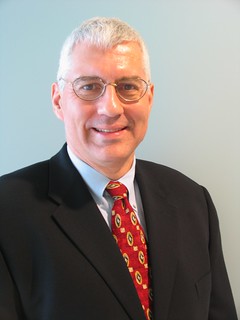 The Burnett Anderson Memorial Award for Excellence in Numismatic Writing is presented annually to a researcher, author or journalist in recognition of their body of work and career contributions to numismatics. First conferred posthumously on its namesake in 1999 at the ANA's 108th Anniversary Convention, the award is intended to celebrate quality and integrity in numismatic wordsmithing of every kind. The recipient is selected in a cooperative process by the ANA, the American Numismatic Society and the Numismatic Literary Guild.
The Burnett Anderson Memorial Award for Excellence in Numismatic Writing is presented annually to a researcher, author or journalist in recognition of their body of work and career contributions to numismatics. First conferred posthumously on its namesake in 1999 at the ANA's 108th Anniversary Convention, the award is intended to celebrate quality and integrity in numismatic wordsmithing of every kind. The recipient is selected in a cooperative process by the ANA, the American Numismatic Society and the Numismatic Literary Guild.
This year's recipient is Joel J. Orosz, a prolific researcher and writer who has been working in the field for four decades. Burnett Anderson's son Mark Anderson accepted the award on Orosz's behalf at the Awards Banquet held August 13 at the World's Fair of ® Money. Orosz found a vocation in philanthropy and an avocation in numismatics. These interests brought balance to his life, for, as he puts it, he dedicated his workdays to giving away large sums of money and spent his leisure hours trying to claw a little bit of it back. Over the years, he has focused on tracing the literary byways of early American numismatics and also on gathering association copies (books inscribed by their authors and notable previous owners).
His numismatic corpus originated in the early 1980s. His research has been published in Rare Coin Review, The Numismatist, The American Journal of Numismatics and several other periodicals, and he is currently a columnist for The Asylum and Coin World. He's authored two numismatic books and coauthored three more. His three most recent works—The Secret History of the First U.S. Mint (2011); Truth Seeker: The Life of Eric P. Newman (2016); and 1792: Birth of a Nation's Coinage (2017)—all received the Numismatic Literary Guild's (NLG) prestigious Book of the Year Award.
The philanthropic numismatist also has been honored with three first-place ANA Heath Literary Awards (2000, 2010 and 2017) and the Wayte and Olga Raymond Memorial Literary Award (2018). In addition to the NLG, Orosz has earned numerous accolades from the Professional Numismatists Guild, the John Reich Collectors Society and the Society of Paper Money Collectors. The Numismatic Bibliomania Society named its annual writer's award after Orosz, who shared the 2020 NLG Clemy Award (the organization's highest honor) with Len Augsburger.
Here's the banquet program text. -Editor
BURNETT ANDERSON MEMORIAL AWARD
for Excellence in Numismatic Writing
Joel J. Orosz is the Distinguished Professor of Philanthropic Studies Emeritus at Grand Valley State University. His second career as a numismatic author has spanned four decades, producing five books and hundreds of columns and articles, with an emphasis on numismatic biographies. Orosz originated "The Numismatic Bookie" column for Coin World, and also serves as a columnist for The Asylum, the quarterly journal of The Numismatic Bibliomania Society. He has authored or co-authored three Numismatic Literary Guild Books of the Year, and three Heath Literary Award-winning articles for The Numismatist, official journal of the American Numismatic Association, as well as sharing the Numismatic Literary Guild's 2020 Clemy Award with his longtime writing collaborator, Len Augsburger. Orosz is a Fellow of the American Numismatic Society; a member of the Rittenhouse Society, and a charter member of the Numismatic Bibliomania Society's Attinelli Fellowship.
And these are Joel's acceptance remarks, read by Burnett's son Mark Anderson, who accepted the award on Joel's behalf. -Editor
Being recognized with the Burnett Anderson Memorial Award is, for a numismatic writer, much like Kansas City for Rodgers and Hammerstein; it means "you've gone about as 'fur' as you can go."
When the American Numismatic Association, the American Numismatic Society, and the Numismatic Literary Guild - the three leading supporters of numismatic scholarship - decide to bestow an award named for Burnett Anderson - the numismatic writer's writer - the recipient can only be humbled by the sheer heft of the honor, and proud of having been chosen for it.
As wonderful as this recognition of past work is, it also presents an obligation to make all future work worthy of the Burnett Anderson standard of numismatic writing. That is a tall order, but one which I gratefully accept. Thank you very much.
WAYNE'S NUMISMATIC DIARY: SEPTEMBER 19, 2021
Here are a couple new and old items I've come across in my numismatic travels recently.
Two-Faced Lincoln Cent Artwork
In August our middle son turned 21 and after a nice dinner with friends and neighbors the menfolk took him up to Maryland for an overnight excursion to the MGM Grand National Harbor casino. An artwork hung in one suite at the Gaylord National Resort hotel was made with Lincoln cents.
The cents were painted various colors and mounted edgewise on the canvas, with different view seen from the left and the right. From the left one sees an American flag; from the right a profile of Lincoln. We were too busy raising our glasses in celebration that I forgot to check for an artist's signature. Is anyone aware of who produced this interesting piece?
Where's George
This week I came across the first Where's George note I've seen in a long time.
I dutifully logged it on the Where's George website. The Series 2009 note was initially reported in 2014 in Saginaw, MI, then travelled through Dayton, OH, Williamsburg and Haymarket VA, before landing with me in Ashburn, VA. It had been nearly a year since its last report.
Have any of our readers handled a Where's George note lately>
To learn where my note has been, see:
Where's George? Bill Tracking Report
(http://www.wheresgeorge.com/b:Gvz32d18PZ)
GEOFFREY BELL 2021 FALL SALE HIGHLIGHTS
Here's a press release with some highlights of the October 1, 2021 Geoffrey Bell Auctions sale at the Toronto Coin Expo. -Editor
Toronto Coin Expo 2021 Fall Sale from Geoffrey Bell Auctions
Geoffrey Bell Auctions Ltd. is proud to present a full lineup of rare and scarce banknotes, coins, tokens, and medals with this year's Toronto Coin Expo Fall Sale. The Toronto Coin Expo , unable to hold an in-person show this year due to the pandemic, is upping their game with the auction portion of the event. Presented over its usual two nights, the Fall Sale sees the Expo team up with two auction partners to present an unprecedented lineup of numismatic material. Keep reading for highlights from Geoffrey Bell Auctions' portion October 1st, 2021.
One of the showpieces is undoubtedly a Royal Bank of Canada 1920, $100. Issued from Georgetown, British Guiana, Geoffrey Bell Auctions is honoured to present this incredible rarity, one of only two recorded in the CPMS Registry. This is not represented as an issued note in the National Currency Collection. Wilson-Holt signatures. Very slightly circulated VF 30 or VF35?, but a little brown staining along bottom edge. CH 630-36-06, S/N: 001303. Part of the Harold Don Allen collection, it has a low estimate of $30,000.
Representing the Bank of Canada, this next note speaks for itself. There will be a lot of attention over this 1937 $1000 Osborne signature graded by PMG Gem UNC 65 EPQ with a nice low serial number. Thousand dollar notes have garnered particular attention from the media and collectors due to the recent loss of their legal tender status. This piece from the TLC collection also has a low estimate of $30,000.
Another centrepiece-worthy item, up for auction is one of Canada's most famous and storied notes, from the Yukon Gold Rush. This is a Canadian Bank of Commerce $5 note of 1892 with blue YUKON overprint, CH 75-14-04c. Note grades a pleasing VF30? with minor soiling on the face, and has a bold manuscript signature. S/N: 295794/C This is also from the Harold Don Allen collection and sports a low estimate of $22,000.
Coin collectors will see a number of key-dates, with the Prince of Canadian Coins at the forefront. The 1921 5-cent fishscale is graded by ICCS as a pleasing VG-8. Also important is an 1885 10-cent piece graded by ICCS MS-62. Both of these have a low estimate of $5,000. Silver dollar collectors will notice a coin with personal history. Canada's first circulation dollar, issued in 1935 is graded by ANACS AU-58 Details. "JOP" Countermark. Type II. Counterstamped above the date on the reverse, bearing the initials J.O.P for Joseph Oliva Patenaude, a private jeweller in British Columbia.
Token collectors will want to check out a nice Bridge Token - Calèche (Carriage). Graded ICCS VF-20. CH# BT-13. Breton 542. Scratches. Canadian medal collectors will notice a rare Ferguson medal, the highest award in Canadian numismatics. And Hudson's Bay collectors won't want to miss a Hudsons Bay Company 1820 One Pound Sterling, 1820 note, MB10-06bi.
We can't mention everything right now, but expect to hear more about gem Devil's Face notes, solid radars, low numbers, rare changeovers, and even a sheet of 1989 tens. Make sure you plan on joining us for the Toronto Coin Expo 2021 Fall Sale September 30th and October 1st.
For more information,
http://www.gbellauctions.com/
HIGHLIGHTS OF THE AXEL TESMER COLLECTION
The Künker firm's fall auction sale includes Part 2 of the Axel Tesmer Collection. Here's a selection of highlights that caught my eye in their September 17, 2021 email newsletter. -Editor
In March, we were pleased to offer you the first part of the Axel Tesmer Collection with coins and medals from Brandenburg-Prussia. Now the second part will be auctioned off. It covers the period from the coronation of Frederick I as King of Prussia to the end of the monarchy.
It is impressive to see how meticulously Axel Tesmer collected objects that document every detail of Prussian monetary history. He did not only appreciate great rarities, he paid special attention to fractional coins which are much more difficult to find when looking for pieces of attractive quality. Roland Trampe describes the collector as follows: In line with his thorough, structured and disciplined manner, Axel Tesmer developed an inventory code and a corresponding cataloguing system for every coin, regardless of whether it was worth 5 DM or more than 10 DM. He did this with great care and attentiveness, and his children sometimes had the feeling that their father's profession was being a coin collector.
A wonderful idea: coin collecting as a full-time job! But isn't it rather the case that collecting coins is a true vocation, enabling a collector to find fulfilment?
Lot number 3155
Frederick I.
2 ducats 1712, Magdeburg.
Very rare. Very fine to extremely fine.
Estimate: 10.000 euros
To read the complete lot description, see:
Friedrich (III.) I., 1701-1713. 2 Dukaten 1712 HFH, Magdeburg. 6.92
(https://www.kuenker.de/en/auktionen/stueck/294770)
Lot number 3161
Frederick I.
Reichstaler 1703, Berlin.
Extremely rare. Very fine to extremely fine.
Estimate: 10.000 euros
To read the complete lot description, see:
Friedrich (III.) I., 1701-1713. Reichstaler 1703 CS, Berlin. 29.26 g. Da
(https://www.kuenker.de/en/auktionen/stueck/294550)
Lot number 3264
Frederick William I.
Double reichstaler 1719, Berlin.
Extremely rare. Extremely fine +.
Estimate: 50.000 euros
To read the complete lot description, see:
Friedrich Wilhelm I., der Soldatenkönig, 1713-1740. Doppelter Reic
(https://www.kuenker.de/en/auktionen/stueck/295185)
Lot number 3334
Frederick II.
Ducat 1745, Berlin.
Extremely rare. Extremely fine to FDC.
Estimate: 10.000 euros
To read the complete lot description, see:
Friedrich II., der Große, 1740-1786. Dukat 1745 EGN, Berlin. 3.47
(https://www.kuenker.de/en/auktionen/stueck/270569)
Lot number 3388
Frederick II.
1/3 reichstaler 1754, Berlin.
2nd known specimen. Extremely fine to FDC.
Estimate: 10.000 euros
To read the complete lot description, see:
Friedrich II., der Große, 1740-1786. 1/3 Reichstaler preuß. 1754 A, Be
(https://www.kuenker.de/en/auktionen/stueck/303807)
Lot number 3860
Frederick II.
Speciestaler 1755, Berlin.
Extremely rare. About FDC.
Estimate: 50.000 euros
To read the complete lot description, see:
Friedrich II., der Große, 1740-1786. Speciestaler 1755 ohne Münzzeic
(https://www.kuenker.de/en/auktionen/stueck/303813)
Lot number 3864
Frederick II.
Levantetaler 1767, Berlin or Magdeburg.
Extremely rare. About extremely fine.
Estimate: 20.000 euros
To read the complete lot description, see:
Friedrich II., der Große, 1740-1786. Levantetaler 1767, Berlin oder
(https://www.kuenker.de/en/auktionen/stueck/300594)
Lot number 3965
Frederick William III.
Pattern for the 1798 taler, Berlin.
Extremely rare. Extremely fine to FDC.
Estimate: 25.000 euros
To read the complete lot description, see:
Friedrich Wilhelm III., 1797-1840. Taler 1798 A. Dav. 2602; J. 26; Ol
(https://www.kuenker.de/en/auktionen/stueck/304063)
Lot number 1817
Frederick I.
Ducat 1701, Berlin.
Very rare. Extremely fine.
Estimate: 6.000 euros
To read the complete lot description, see:
Friedrich (III.) I., 1701-1713. Dukat 1701 LCS, Berlin. 3.46 g. Fb. 2296
(https://www.kuenker.de/en/auktionen/stueck/302705)
Lot number 5366
Frederick William.
Reichstaler 1675, Berlin.
Extremely fine.
Estimate: 3.500 euros
To read the complete lot description, see:
Friedrich Wilhelm, der Große Kurfürst, 1640-1688. Reichstaler 1675,
(https://www.kuenker.de/en/auktionen/stueck/198292)
KüNKER OFFERS 1870 JAPAN 20 YEN
Künker is also offering a very rare and important Japanese coin in its upcoming sale. -Editor
A New Currency for a New Japan
On 27 September 2021, an icon of Japanese coinage will be auctioned off as part of the Schwarz Collection offered by Künker: the 20 yen piece of 1870 of which only very few specimens were minted to be given to dignitaries of the imperial court. We tell its story.
The fast industrialization of Japan, which started in the years after 1868, did already amaze and impress those who witnessed it at the time. While other Far Eastern countries of the 19th century became more and more dependent on western countries, Japan managed to stay independent while making use of European technology and know-how. The foundations for this development were laid during the Boshin civil war.
... So That We Would Not Suffer the Same Fate as India and China
The Boshin War marked the beginning of the Miji era, i.e. the period between 25 January
1868 and 30 July 1912. The opponents were, on the one side, the supporters of the Tokugawa
shogunate, on the other side all those who wanted a strict central government under the rule of
young Emperor Mutsuhito. The underlying cause for this military conflict was Japan's
economy: the opening of Japan had triggered a rampant inflation. Every Japanese was
affected. Prices had risen by more than 650% on average, and the price of rice, a highly
important foodstuff, had increased by as much as 800%.
Above all, educated young people blamed the policies of the Tokugawa shogunate for the economic misery. When Emperor Komei died on 30 January 1867, they hoped for a new beginning under the rule of the just 14-year-old Emperor Mutsuhito, who chose the meaningful throne name Meiji (= enlightened rule). What remains remarkable about the Boshin War is the fact that both the victors and the defeated deliberately rejected foreign aid, which, by the way, would have certainly been offered. France, in particular, could only be kept from intervening in the war with much effort and diplomacy.
The reason why the political powers of Japan did not want aid from other countries were
expressed by the commander of Edo on the occasion of the surrender on 6 April 1868: Since
the outbreak of the so-called foreign crisis, the Tokugawa did not only hold council among
themselves but informed the [entire] empire, not thinking about their own benefit so that we
would not suffer the same fate as India and China.
Japan as a Client
Thus, Japan was not politically obliged to any western power after the change of rule and
could choose its business partners based on economic rather than diplomatic considerations. It
became a client eagerly courted by all countries.
The corps formed by young civil servants (the average age of them was just over 30 years) were ready to break new ground. The Iwakura Mission – during which high-ranking politicians negotiated the repeal of unequal treaties and, at the same time, studied and evaluated western institutions – became legendary. When this mission started at the end of 1871, Japan already had a new currency and its own mint, where western-style coins were produced – a clear sign of the importance the government attached to a new currency for the recovery of Japanese economy.
The Mint of Hong Kong Was Transferred to Osaka
As early as in 1868, the Japanese Minister of Finance took care of the monetary issue. He was
lucky: the British mint in Hong Kong was dissolved, and Japan was able to obtain the entire
equipment of the mint. The minister even succeeded in convincing the former mint director
Thomas William Kinder to come to Japan. He received a salary of $1,045 per month, making
him one of the best-paid foreigners in Japan. When he came to Osaka in 1870, another
foreigner, Thomas James Water, had already erected the buildings for the new mint.
The location they chose was Osaka, the trade hub of the time, which was to develop into
Japanese Manchester
over the following decades. One reason for this was the mint, which
turned out to be a center of innovation. Here, western-style manufacturing methods were
adapted for numerous products that Japan had not produced industrially before. Thus, mint
director Kinder equipped his mint with gasworks for lighting and began producing sulfuric
acid in Osaka. Sulfuric acid was then, as is today, one of the most widely produced chemical
substances, which is why its production volume is considered an indicator of a country's
degree of economic development.
Incidentally, western habits spread from the mint to the city of Osaka: the employees demonstratively wore western-style clothes and decided to go without the sword and the traditional samurai topknot.
A New Currency
In 1869, the Japanese government decided to abandon the old currency hotchpotch in favor of
a single national currency. What this means is illustrated by a survey of the Japanese Ministry
of Economy of 1868: it found that between 1603 and 1867, a total of 1,694 different
denominations had been issued and were still circulating. They were all to be replaced with
new western-style coins based on the decimal system. They were called yen
due to the
circular shape of the coin. Yen
simply means circle
or round
.
Three important Japanese artists created the design for the new single currency: it depicts a dragon on the obverse and the sun on the reverse as a reference to the Japanese Tenno – the emperor was considered to be the descendant of both Amaterasu, the sun goddess, and Watatsumi, the dragon god.
This design was sent to the Royal Mint in London, where Leonard Charles Wyon created dies for eight denominations. This resulted in patterns created by the Royal Mint, probably in the hope of winning Japan as a customer. But when the patterns arrived in Japan in April 1870, the mint in Osaka was already well-equipped to mint their own coins.
Was it a matter of national honor not to adopt the British design but to modify it? Anyway, the reverse was extensively revised and an additional denomination was created: the golden 20 yen piece.
Künker is able to offer one of these icons of Japanese coinage as an outstanding object from the of the Schwarz Collection, which will be auctioned off in sale 352 on 27 September 2021. The piece was purchased in 1937 at the Munich coin dealer Helbing. Since then, it has been part of the Hermann Schwarz Collection. Its outstanding quality, NGC graded it MS 65+, is due to the fact that it never entered circulation.
We can think of this 20 yen piece as sort of a pattern that was created before the law on the new currency was adopted in 1871. The few pieces that were minted before this date were probably exclusively given to the emperor and high-ranking officials. One might even assume that they were presented on the occasion of the Tenno's visit to the Osaka mint. After all, we know that the Japanese Emperor visited the mint in person. How proud Thomas William Kinder was about this is demonstrated by the fact that this visit was even mentioned in his obituary. The Tenno seemed to have honored his mint master: Kinder was officially received at the imperial court three or four times before his departure in 1875.
Kinder left behind a well-functioning mint and qualified technicians capable of supplying their country with the coins it needed for its economic advancement. Thus, the 20 yen piece of 1870 is an impressive symbol for Japan's ability to make use of western-style technologies to the benefit of its own prosperity.
For more information, see:
https://www.kuenker.de/en/
NUMISMATIC NUGGETS: SEPTEMBER 19, 2021
Here's a selection of interesting or unusual items I came across in the marketplace this week. Tell us what you think of some of these. -Editor
Faustina Jr. (Wife of Marcus Aurelius) AV Aureus, Rome AD 148-150, 7.20g. FAVSTINA AVG PII AVG FIL, draped bust of Faustina right. Rev. CONCORDIA, dove right. (RIC 503; Calico 2045 (same dies)). Strong strike. Extremely Fine.
Looking for a gift for that special coin collector? Give 'em the bird! From Baldwin's October 2021 sale. -Editor
To read the complete lot description, see:
Faustina Jr. (Wife of Marcus Aurelius) AV Aureus
(https://auctions.baldwin.co.uk/103-lot-25-c212011420)
Thrace. Abdera.
Tetrobol (silver). Approx. 311-280 BC BC Vs: Griffin positioned to the left, club below; in the section Magistrate Name Antigo. Rs: head of Apollo on the right in a line rectangle.
13 mm. 1.73 g.
May -; HGC 3, 1230.
Rare . Almost extremely fine.
Coll. Prof. Dr. Peter Robert Franke
Interesting framing of the portrait. From the Solidus Auction 81 closing September 21, 2021. -Editor
To read the complete lot description, see:
Lot 81. Thrace. Abdera.
(https://www.sixbid.com/de/solidus-numismatik/8817/thrakien/7412452/thrakien-abdera)
BELGIUM, TOKEN, SAINT LAMBERT - LIÈGE
1653 - VF(30-35) - Copper
Halloween is coming. Check out the skull and crossbones on this 17th century Belgian token offered by Numiscorner. -Editor
To read the complete item description, see:
BELGIUM, TOKEN, SAINT LAMBERT - LIÈGE
(https://www.numiscorner.com/products/belgium-token-saint-lambert-liege-1653-vf30-35-copper-1)
USA 1888 1 dollar gold fine specimen High Grading PCGS PR 66+ DCAM Proof
From a small group of U.S. gold in the November 26th, 2021 Münzen & Raritätenshop GmbH (Switzerland) sale. -Editor
To read the complete lot description, see:
LOT.NO:564 USA 1888 proof
(https://www.muenzenonline-auktion.ch/catalogDetail/detail/auktion-nr.15-1622621449/USA-1888-Proof--566787)
FEDERAL FUNNYMONEY NOTES, 1968 CRISP UNC
I don't know that I'd call these "Money Art", but they're some sort of political satire piece. It's hard to read, but I think I can make out "Help Stamp Out Fiat Money" and "FOOL's GOLD". Is anyone familiar with these? -Editor
To read the complete lot description, see:
17-TWENTY NOTHING UNITED SLAVES OF AMERICA
(https://auctions.bidalotcoinauction.com/lots/view/1-50CWAW/17-twenty-nothing-united-slaves-of-america)
I came up empty in online searches, but did come across this great parody Greenback note c1880. It's already sold, unfortunately. It has references to "Swindleville Avenue, Washington City" and calls "Burn the BONDS" and "Shoot the BONDHOLDER." Click on the images to see larger versions in our Flickr archive. -Editor
To read the complete lot description, see:
[C.1880 Uncle Sam Satirical Greenback
Political Bank Note].
(https://www.rareamericana.com/pages/books/3725620/benjamin-f-butler/c-1880-uncle-sam-satirical-greenback-political-bank-note)
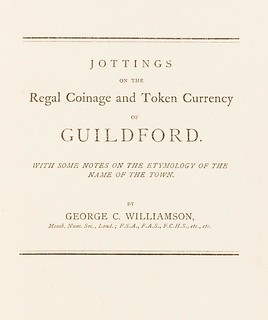 Numismatics.- Williamson (George C.) Jottings on the Regal Coinage and Token Currency of Guildford. With Some Notes on the Etymology of the Name of the Town, presentation copy from the author with his ink inscription on fly-leaf, ink ownership signature of George James Jacobs and ink stamp on fly-leaf, 36pp., original printed wrappers, torn with loss to edges, 8vo, Guildford, [1884].
Numismatics.- Williamson (George C.) Jottings on the Regal Coinage and Token Currency of Guildford. With Some Notes on the Etymology of the Name of the Town, presentation copy from the author with his ink inscription on fly-leaf, ink ownership signature of George James Jacobs and ink stamp on fly-leaf, 36pp., original printed wrappers, torn with loss to edges, 8vo, Guildford, [1884].
Something for the bibliophiles or British token collectors. -Editor
To read the complete lot description, see:
Lot 142: Numismatics.- Williamson (George C.) Jottings on the Regal Coinage and Token Currency of Guildford, presentation copy from the author, original printed wrappers, Guildford, [1884].
(https://www.invaluable.com/auction-lot/Numismatics.-Williamson-George-C.-Jottings-on-142-c-E264224BDC)
1967 AUSTRALIA PATTERN DOLLAR
We discussed the 1967 Australia pattern dollar in 2020 when one appeared in the Stephen Album Auction 37. Stack's Bowers Auction Services Associate Nicholas Fritz published a blog article about about an example coming up in their Hong Kong sale. -Editor
In our Fall 2021 Hong Kong auction, we have many interesting numismatic offerings, including a 1967 Australia so-called pattern dollar. On Valentine's Day 1966, Australia officially decimalized and converted to the Australian dollar, transitioning from the traditional 240 pence for one Pound system that had been introduced by the British when the Australian Pound was created in 1910. Australian numismatists were disappointed by the exclusion of a one-dollar coin from Australia's new decimal coinage, eschewed for a paper bill. To remedy this, John Gartner, founder of the Australian Coin Review, sponsored a design competition for a pattern dollar. The winning dollar was designed by Andor Meszaros and submitted to the government for review. Rebuffed by the government, Gartner decided to take matters into his own hands and commission the minting of a private pattern dollar.
The striking was untaken by the John Pinches Medalists Company in London. Founded circa 1841 by Thomas Ryan Pinches and his younger brother John Pinches, the company struck many commemorative medals for the British Empire and the later Commonwealth of Nations. In 1967, the private pattern dollars were struck: 1,500 Uncirculated with a milled edge, 750 Proof with a plain edge, and 10 pieces in gold also with a plain edge. The Uncirculated coins sold at an original price of $10 and the Proofs at $13.50. The John Pinches Medalists company was subsequently bought by the Franklin Mint in 1969, making this pattern dollar one of the last issues of the company before it was acquired. The example featured in our Hong Kong auction is estimated at $800-$1,200, significantly more than the original $10 price in 1967.
This coin tells the story of Australia's transition from one currency to another, and remains a popular issue of Australian numismatics, highly sought after by collectors of both coins and medals. The 1967 Australia pattern dollar, along with the nearly 6,000 other lots of coins, tokens, and medals included in Fall Hong Kong auction are available for viewing and bidding at StacksBowers.com.
To read the lot description, see:
AUSTRALIA. Silver Dollar Pattern, 1967. PCGS MS-64.
(https://auctions.stacksbowers.com/lots/view/3-T159I/australia-silver-dollar-pattern-1967-pcgs-ms-64)
To read the complete article, see:
Australia's Transition from Pence to Cents
(http://www.stacksbowers.com/News/Pages/Blogs.aspx?ArticleID=australia-1967-pattern-dollar-stacks-bowers-galleries-upcoming-auction-highlight)
To read the earlier E-Sylum article, see:
STEPHEN ALBUM AUCTION 37 SELECTIONS : Lot 2000: 1967 Australia Pattern Dollar
(https://www.coinbooks.org/v23/esylum_v23n21a23.html)
ROYAL MINT RESUMES PENNY PRODUCTION
David Pickup passed along two articles about the resumption of penny production at the Royal Mint. Thanks. -Editor
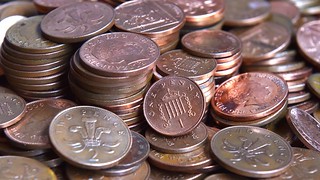 One penny coins were back in production last year after none were minted for general circulation in the previous two years, Royal Mint figures show.
One penny coins were back in production last year after none were minted for general circulation in the previous two years, Royal Mint figures show.
Covid lockdowns meant that many coins were hoarded at home requiring some to be produced for use in the economy.
Banks recently called on people to donate unused loose change to charities after the pandemic hit fundraising.
Some 88 million new 1p coins were minted in 2020 - still well below the levels seen before the two-year pause.
The figures show that no new £2 coins have been minted for four consecutive years, and no new 2p coins have been produced for three years.
The Royal Mint has previously stated that it had no plans to resume production of these coins for 10 years, owing to a coin mountain that exists while demand has dropped.
David adds:
"It does not say if the coins minted in 2020 will be dated that year.
I suspect coins are not being hoarded
- they are not being used as most transactions are by card now."
To read the complete articles, see:
Pennies back in production as cash is hoarded during Covid
(https://www.bbc.com/news/business-58560185)
One penny coins back in production with over 88 million made by Royal Mint last year
(https://news.sky.com/story/one-penny-coins-back-in-production-with-over-88-million-made-by-royal-mint-last-year-12408373)
CHITTY BANG BANG MEDAL
This Baldwin's blog article discusses a medal belonging to Count Zboroswki, inspiration for the book and movie Chitty Chitty Bang Bang. -Editor
A pioneer of motor racing in the early 20th Century, Louis Vorow Zboroswki was the son of a wealthy American aristocrat. A colourful figure, he would go on to design and build his own racing cars, the first of which was named ‘Chitty Bang Bang'. Throughout his career, he participated in many motor races across the world, as well as the legendary Indianapolis 500 in 1923.
The silver medal dates to the following year, 1924, where Zborowski took part in speed trials organised by the Kent Automotive Club where they were held on a sunny Saturday on the Herne Bay seafront. While he didn't win any of the classes – in his Mercedes he gave the favourite, Leon Cushman, a run for his money, finishing second in the unlimited racing-car class.
Count Zborowski had joined the Mercedes racing team that year and it was during the Italian Grand Prix at Monza that tragedy struck. On the 19th October 1924, mere months after this medal was awarded, the count's Mercedes hit a tree on the Curve de Lesmo, killing him instantly.
Count Zborowski's legacy would live on in an unusual way. Unbeknownst to Zborowski, he had inspired the esteemed writer, Ian Fleming, who would watch the driver race at Brooklands during his youth. Fleming's children's book, Chitty Chitty Bang Bang, featured the Count as a key character – the title car being directly based on those he had designed. The 1968 musical adaptation would go on to be an enormous hit, bringing joy to many through film and theatre.
To read the complete article, see:
THE MEDAL OF THE INVENTOR OF CHITTY BANG BANG
(https://www.baldwin.co.uk/news/the-medal-of-the-inventor-of-chitty-bang-bang/)
US COLONIAL PAPER MONEY: AN INTRODUCTION
In his World Banknote Auctions blog, Dennis Hengeveld published an overview of U.S. colonial paper money. -Editor
US Colonial Paper Money: An Introduction
In 1690 the Colony of Massachusetts issued what would be the first paper currency introduced in North America. While Paper Money had been first printed in China hundreds of years earlier, what we now know as Colonial US Paper Money was the first large issuance of banknotes in the western world. The thirteen original colonies which would later form the United States of America all issued paper money, and many of these notes are surprisingly affordable. In this article we will give some collecting ideas of these fascinating pieces. Thanks to the relative affordability of these notes they are within reach of many collectors. While generally collected within the scope of US Paper Money world collectors will find such issues interesting as well, as many were issued under British rule and as a result they will easily fit in an advanced world collection as well.
One of Each of the Original Thirteen Colonies
A basic collection that many collectors attempt to assemble is a single note from each of the original thirteen colonies: Delaware, Pennsylvania, New Jersey, Georgia, Connecticut, Massachusetts, Maryland, South Carolina, New Hampshire, Virginia, New York, North Carolina and Rhode Island. A collection such as this is relatively easily assembled, although it can become more challenging by only seeking out those issued prior to the Declaration of Independence. Additionally, many collectors include Vermont (the 14th State) in such a collection, although this makes completion very difficult, as Vermont issued just a single series (dated February 1781) of which just 3,600 pieces of each denomination were printed. Most Vermont pieces are repaired or otherwise impaired, and finding high quality examples is extremely difficult.
Collecting Notes from Famous Printers
While not a typical way of collecting. a study of the various printers of Colonial Paper Money is interesting, and can provide much insight into these historic notes. Among the printers that printed these notes is Benjamin Franklin, who worked as a printer in Philadelphia. His imprint is seen on notes from Delaware, New Jersey and Pennsylvania, and are a tangible object produced by the famous statesman that is within reach of many. Other prolific and famous printers include Henry Dawkins, David Hall (first as partner of Benjamin Franklin and later with William Sellers) and Paul Revere.
There are endless possibilities when collecting these historic pieces, especially when one considers the time period that they were issued and the fact that that these notes were widely accepted by a population that previously had only used coins in commerce. If you are interested in reading more about these notes we can recommend The Early Paper Money of America by Eric P. Newman, a full catalog and the most important reference work on these issues.
To see a small selection of US Colonial Paper Money in our current auction, including the pieces illustrated above, please visit www.worldbanknoteauctions.com.
To read the complete article, see:
US Colonial Paper Money: An Introduction
(https://mailchi.mp/worldbanknoteauctions/wbna-blog-colonials-5372794)
NEW ZEALAND FEMINIST KATE SHEPPARD
This article discusses women's suffrage leader Kate Sheppard, who appears on a $10 New Zealand banknote. -Editor
In 1992 four New Zealand icons (and the queen) appeared on new banknotes. Part of creating national identity, these notable citizens were chosen to represent the pinnacles of achievement.
Apirana Ngata, Edmund Hillary, Ernest Rutherford and Kate Sheppard — all in circulation so their acts and values can be admired, celebrated and emulated.
Collectively, the banknote icons signalled a bicultural nation that celebrates Maori knowledge and success, a place where women are equal and where it is possible to lead the world, including in science and exploration.
So what of Kate Sheppard's position? A year after she graced the $10 note, she was put on another pedestal, literally. Unveiled in 1993, the national memorial provides a useful interpretation of the suffrage leader's place in the collaborative women's movement of the late 19th century.
The memorial's Christchurch location, Sheppard's name in its title and her central position cast in bronze all recognise her leadership. But the monument also recognises how, after the victory, she brought together the networks that had formed during the suffrage campaign.
Sheppard became the first president of the National Council of Women (NCW) in 1896, but flanking her in bronze are others central to the women's movement.
To read the complete article, see:
On the money: Kate Sheppard and the making of a New Zealand feminist icon
(https://theconversation.com/on-the-money-kate-sheppard-and-the-making-of-a-new-zealand-feminist-icon-167627)
BOGGS, TUBMAN AND U.S. PAPER MONEY
Together with Robert Cavalier of Carnegie Mellon University, I recently wrote an article for CoinWeek about the Harriet Tubman note produced by our mutual friend J.S.G. Boggs. Here's an excerpt; be sure to see the complete article online. -Editor
The proposed Harriet Tubman $20 bill would not be the first time the famed abolitionist and women's suffragist appeared' on a United States banknote. The fascinating tale begins in the early 1990s, when the
Money Artist
J.S.G. Boggs came to Pittsburgh, invited by Carnegie Mellon's Center for the Advancement of Applied Ethics (CAAE).
He spent the first month or so at the home of Robert Cavalier, a member of CAAE specializing in interactive multimedia. While there, he made a number of phone calls to England costing about $90. Boggs reimbursed Cavalier with a newly drawn $100 bill featuring a young Harriet Tubman. Therein lies a tale – one involving artists, historians, philosophers, and numismatists along with the US Treasury.
A 1989 profile of Boggs by The New Yorker's Lawrence Weschler piqued the Center's interest in approaching Boggs and using his work in a new project.
The Center's Director, Preston Covey, figured out a way to hire him as a scholar-in-residence. Boggs liked the honorific offering and jumped at the opportunity to use the Center's new imaging technologies. He was just getting into using color and Photoshop and produced the first version of ‘coloured money'. This is how Boggs came to ‘reimburse' Cavalier with his Tubman bill (creatively choosing a younger image of her
).
Boggs was not a political activist except when it came to the freedom to express himself through his art. But he could certainly be characterized as a liberal in many matters. This was most probably the reason that he selected Harriet Tubman for his first piece in color, using the British spelling coloured art
. He also wanted to show an imagined young Harriet Tubman
, one not scarred by the life of an American slave.
Art is often a vehicle for expressing political thought. With his Women's Series, Boggs sought to bring attention to the gallery of old white men
depicted on our currency, opening the door to future honorees of different eras, races, and genders.
Was Boggs a seer or trailblazer? He certainly visualized a new world in which our nation's money is more inclusive and reflective of the actual populace. But bringing that vision to fruition is a lengthy, fraught, and frustrating start/stop process. Boggs, who died in 2017, would not live to see Tubman on a U.S. Federal Reserve Note.
To read the complete article, see:
Tubman, Jackson, and Boggs: How Art Predicted the Future of US Paper Money
(https://coinweek.com/paper-money-2/tubman-jackson-and-boggs-how-art-predicted-the-future-of-us-paper-money/)
ZIMBABWE ARTIST TURNS NOTES INTO PAINTINGS
An artist in Zimbabwe is repurposing old banknotes. -Editor
If anyone doesn't need reminding that banknotes are just worthless pieces of paper, it is Zimbabweans: more than a decade ago, they watched as hyperinflation obliterated their currency and led to the printing of a 100 trillion Zimbabwean dollar note.
Zim dollars were abandoned in 2009, after inflation caused by rampant money printing under the late President Robert Mugabe erased everyone's savings and pushed millions into poverty.
Most bills ended up in the trash, but Zimbabwean visual artist Prudence Chimutuwah has found value in the unloved old bank notes - by using them to make art.
Chimutuwah wants Zimbabweans to look beyond the ugly history of the inflation - considered by the International Monetary Fund as the worst of any peacetime country - to see something beautiful in the bills. And, in the process, perhaps recover from the trauma of that time.
"A lot of people, when they see the old bank notes, their reaction most of the time (is to) get angry," said Chimutuwah.
"I am trying ... for people to see the beauty of these old bank notes. So, when someone looks at this artwork they go like 'whoa' and then they forget the pain this thing has caused."
Her paintings capture the daily lives of women, shown dancing, cooking or in bright and elegant dress, with the old Zim dollar notes stuck on with glue to form part of the image.
To read the complete article, see:
Zimbabwe artist turns worthless old Mugabe-era banknotes into paintings
(https://www.reuters.com/lifestyle/zimbabwe-artist-turns-worthless-old-mugabe-era-banknotes-into-paintings-2021-09-16/)
THE BOOK BAZARRE
WHEN THE WILD BUNCH FIRST GRABBED GOLD
Butch Cassidy and the Sundance Kid stole their first sack of gold coins in this day in 1900. Here's a piece from today's Writer's Almanac. -Editor
 On this day in 1900 Butch Cassidy and the Sundance Kid committed their first robbery together taking $32,640 from the First National Bank of Winnemucca, Nevada. They were a part of the "Wild Bunch Gang," a group of ruffians and robbers who committed the longest string of successful bank robberies in American history. Most of the Winnemucca loot was in gold coin. Witnesses said the robbers wore masks. It was a midday robbery and quite daring, though the escape left something to be desired: as the robbers fled, they dropped a sack of gold by a creek and had to go back and retrieve it. They had fresh horses waiting, though, and soon were on their way. The citizens of Winnemucca organized a posse and even used a yard locomotive to pursue the robbers.
On this day in 1900 Butch Cassidy and the Sundance Kid committed their first robbery together taking $32,640 from the First National Bank of Winnemucca, Nevada. They were a part of the "Wild Bunch Gang," a group of ruffians and robbers who committed the longest string of successful bank robberies in American history. Most of the Winnemucca loot was in gold coin. Witnesses said the robbers wore masks. It was a midday robbery and quite daring, though the escape left something to be desired: as the robbers fled, they dropped a sack of gold by a creek and had to go back and retrieve it. They had fresh horses waiting, though, and soon were on their way. The citizens of Winnemucca organized a posse and even used a yard locomotive to pursue the robbers.
The money was never recovered and, in fact, no one really knew for sure if Butch Cassidy was even there; some said he was actually in Tipton, Wyoming, planning another robbery during the Winnemucca escapade. The American Bankers Association even brought in the famed Pinkerton Detective Agency, but they never discovered the robbers' identities either.
The Wild Bunch committed robberies across New Mexico, Wyoming, Nevada, and South Dakota. They robbed banks, trains, whatever they felt they could get away with. One of their largest hauls was from a train outside Folsom, New Mexico, when they stole away with more than $70,000.
No one knows for sure what happened to Butch Cassidy and the Sundance Kid. The Pinkertons got closer to apprehending them every day, and one theory is that they hotfooted it to Bolivia where they were killed by soldiers in 1908. Others claim they returned and settled down to lives of anonymity in small western towns.
One thing is for sure: Winnemucca, Nevada, doesn't seem to hold a grudge against Butch Cassidy or the Sundance Kid. Every September, the town stages "Butch Cassidy Days," a rollicking re-enactment of that long-ago robbery.
Money associated with famous crimes is an interesting collecting sideline, but the pickings are slim, as it's hard to trace with any certainty, especially coins. But that pre-1900 U.S. gold coin in your collection just might have been part of the famed Winnemucca robbery take. At least, that's what you can tell people to spice it up. -Editor
To read the complete article, see:
The Writer's Almanac for Sunday, September 19, 2021
(https://www.garrisonkeillor.com/radio/twa-the-writers-almanac-for-september-19-2021/)

